-
 Mokkō form iron tsuba carved in relief and inlaid with soft metals (copper, gold, silver) with the design of a cormorant fisherman on the face and a boat on the reverse. Unsigned. Dimensions: 77 mm x 69 mm x 3.0 mm (at seppa-dai) Edo period: 18th or 19th century. "Since Nara period, Japanese fishermen in small boats have used cormorants (u) to catch river fish at night, binding the necks of the birds so that the fish are not swallowed. [...] The bird and the work it performs are symbols of selfless devotion to one's master and keen eyesight." - from Merrily Baird. Symbols of Japan. Thematic motifs in art and design. Rizzoli international publications, Inc., 2001; p. 104. See also in this collection TSU-0212 and TSU-0241.
Mokkō form iron tsuba carved in relief and inlaid with soft metals (copper, gold, silver) with the design of a cormorant fisherman on the face and a boat on the reverse. Unsigned. Dimensions: 77 mm x 69 mm x 3.0 mm (at seppa-dai) Edo period: 18th or 19th century. "Since Nara period, Japanese fishermen in small boats have used cormorants (u) to catch river fish at night, binding the necks of the birds so that the fish are not swallowed. [...] The bird and the work it performs are symbols of selfless devotion to one's master and keen eyesight." - from Merrily Baird. Symbols of Japan. Thematic motifs in art and design. Rizzoli international publications, Inc., 2001; p. 104. See also in this collection TSU-0212 and TSU-0241. -

Thin six-lobed iron plate of brownish color is carved on each side with a groove that follows the rim and a concentric grooves around the center of the plate, also carved with six thin scroll lines (mokkō or handles, kan) that follow the shape of the rim. Mokume surface treatment. Hitsu-ana possibly added at a later date, and kogai-hitsu-ana plugged with gold. Silver sekigane.
Signed: Kunihide [國秀]. Higo school, 1st generation swordsmith.
Mid Edo period, ca. 1800.
Would be possibly attributed to Kamakura-bori school revival of the 19th century.
References: Nihon Tō Kōza, Volume VI / Japanese Sword / Kodōgu Part 1, page 231: Enju Kunihide, a tōshō from Higo: "...forging of the jigane is excellent, and there are also pieces with mokume hada."
Haynes Index Vol. 1, p. 741, H 03569.0: "Enju Kunihide in Higo province, died 1830, student of Suishinshi Masahide. Retainer of the Hosokawa Daimyō, etc."
Additional Information from Markus Sesko: This tsuba indeed is made by Enju Kunihide, who in his later years signed the HIDE [秀] character as HI [日] and DE [出], as here: Size: 77.4 x 74.9 x 2.7 mm
Similar pieces are:
1. In this collection № TSU-0341: Kamakura-bori tsuba with mokkō motif. Muromachi period, 15th - 16th century.
2. Dr. Walter A. Compton Collection, 1992, Christie’s auction, Part II, pp. 14-15, №16: “A kamakurabori type tsuba, Muromachi period, circa 1400. The thin, six-lobed iron plate is carved on each side with a wide groove that follows the shape of the rim, and with six scroll lines and a single thin circular groove. […] The hitsu-ana was added at a later date, circa 1500-1550. Height 8.3 cm, width 8.6 cm, thickness 2.5 mm. The tsuba was initially intended to be mounted on a tachi of the battle type in use from Nambokucho to early Muromachi period (1333-1400)”. Sold at $935.
Size: 77.4 x 74.9 x 2.7 mm
Similar pieces are:
1. In this collection № TSU-0341: Kamakura-bori tsuba with mokkō motif. Muromachi period, 15th - 16th century.
2. Dr. Walter A. Compton Collection, 1992, Christie’s auction, Part II, pp. 14-15, №16: “A kamakurabori type tsuba, Muromachi period, circa 1400. The thin, six-lobed iron plate is carved on each side with a wide groove that follows the shape of the rim, and with six scroll lines and a single thin circular groove. […] The hitsu-ana was added at a later date, circa 1500-1550. Height 8.3 cm, width 8.6 cm, thickness 2.5 mm. The tsuba was initially intended to be mounted on a tachi of the battle type in use from Nambokucho to early Muromachi period (1333-1400)”. Sold at $935.
 3. And another one in Robert E. Haynes Catalog #9 on page 24-25 under №23: “Typical later Kamakura-bori style work. This type of plate and carving show the uniform work produced by several schools in the Muromachi </em period. Some had brass inlay and others were just carved as this one is. The hitsu are later. Ca. 1550. Ht. 8.8 cm, Th. 3.25 mm”. Sold for $175.
3. And another one in Robert E. Haynes Catalog #9 on page 24-25 under №23: “Typical later Kamakura-bori style work. This type of plate and carving show the uniform work produced by several schools in the Muromachi </em period. Some had brass inlay and others were just carved as this one is. The hitsu are later. Ca. 1550. Ht. 8.8 cm, Th. 3.25 mm”. Sold for $175.

-
 Iron tsuba of ryō-mokko-gata form decorated with a spotted deer (Nara deer or sika deer) motif in low relief carving (sukidashi-bori) and flat silver inlay (hara-zōgan); deer's eyes and details in gold inlay. Signed on a copper cartouche: Noriyuki. Grass in low relief carving on the reverse. There were two Noriyuki in Hamano school - father (Noriyuki I, 1736-1787) and son (Noriyuki II, 1771-1852). Frankly speaking, I don't know which one made this particular piece. Edo period, late 18th or early 19th century.
Iron tsuba of ryō-mokko-gata form decorated with a spotted deer (Nara deer or sika deer) motif in low relief carving (sukidashi-bori) and flat silver inlay (hara-zōgan); deer's eyes and details in gold inlay. Signed on a copper cartouche: Noriyuki. Grass in low relief carving on the reverse. There were two Noriyuki in Hamano school - father (Noriyuki I, 1736-1787) and son (Noriyuki II, 1771-1852). Frankly speaking, I don't know which one made this particular piece. Edo period, late 18th or early 19th century.Size: 71.5 x 70.0 x 3.0 mm.
-

Iron tsuba of oval form with the design of two immortals (Gama Sennin with the toad upon his head and Tekkai Sennin with his iron crutch) beside a waterfall carved in low relief with a high relief effect (takabori) and with details inlaid in gold. A waterfall carved on the reverse. Nakago-ana is plugged with copper sekigane. Unsigned. Allegedly, Mito School.
Edo period, ca. 1700.
Size: Height: 87.0 mm; Width: 82.8 mm; Thickness: 4.4 mm; Weight: 179 g.
No longer available. -
 Evening Snow on Mount Hira (Hira no bosetsu), from the series Eight Views of Ōmi in Modern Guise (Ryaku Ōmi hakkei, (略近江八景). About 1773–75 (An'ei 2–4). Artist: Isoda Koryūsai (Japanese, 1735–1790) CATALOGUE RAISONNÉ: Hockley 2003, p. 202, #F-21-1 DIMENSIONS: Vertical chûban; 26 x 19.3 cm (10 1/4 x 7 5/8 in.)Signed: Koryû ga [湖竜画]
Evening Snow on Mount Hira (Hira no bosetsu), from the series Eight Views of Ōmi in Modern Guise (Ryaku Ōmi hakkei, (略近江八景). About 1773–75 (An'ei 2–4). Artist: Isoda Koryūsai (Japanese, 1735–1790) CATALOGUE RAISONNÉ: Hockley 2003, p. 202, #F-21-1 DIMENSIONS: Vertical chûban; 26 x 19.3 cm (10 1/4 x 7 5/8 in.)Signed: Koryû ga [湖竜画] -
 Isoda Koryūsai (礒田 湖龍斎, 1735–1790), flourished: 1769 to 1790. The print lacks signature (signature erased).
Isoda Koryūsai (礒田 湖龍斎, 1735–1790), flourished: 1769 to 1790. The print lacks signature (signature erased).Attributed definitely to Koryūsai: Jacob Pins, #491 [p.202] - Saigyo Hoshi admiring Mount Fuji. Signature erased but convincingly attributed to Koryusai. Tikotin Museum, Haifa. Catalogue raisonné: Allen Hockley: A3-J-5 (p. 261).
Saigyō Hōshi (西行 法師, 1118 – March 23, 1190) was a famous Japanese poet of the late Heian and early Kamakura period. -
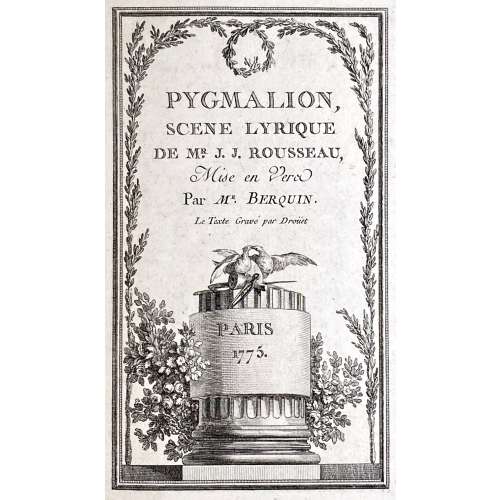 One volume, 22.8 x 15.5 cm, bound in full mottled calf, gilt floral frames to covers, raised bands and gilt fleurons to spine, printed on laid paper. Regarding Pygmalion, scène lyrique see: Wekipedia. Collation: Free endpaper and two blank flyleaves, [2] engraved title, [2] préface, 1-18 (Pygmalion), [2] f.t.p., [1] 2-8 (Idylle), two blank flyleaves and free endpaper; 20 leaves total, adorned with 7 headpieces and 1 tailpiece engraved by Nicolas de Launay, Nicolas Ponce and Charles Etienne Gaucher after Jean Michel Moreau the Younger and Clément Pierre Marillier; text engraved by Droüet. Title-page: PYGMALION, | SCENE LYRIQUE | DE MR. J. J. ROUSSEAU, | Mise en Vers | par MR. Berquin. | Le Text Gravé par Droüet | PARIS | 1775. || (on a column under two kissing doves and sculptor’s tools). Faux t.p.: IDYLLE | Par MR. Berquin. | — | Eructavit cor meum verbum bonum ; | dico ego opera mea regi. | Psalm. 44. | — || (in rules). Catalogue raisonné: Cohen-DeRicci 141 ; Lewine 55. Ref.: MFA (Boston); MET (NY); Yale University Library. Contributors: Artists: Jean-Michel Moreau le Jeune (French, 1741–1814) Clément Pierre Marillier (French, 1740–1808) Engravers: Nicolas Delaunay (French, 1739–1792) Charles-Étienne Gaucher (French, 1741–1804) Nicholas Ponce (French, 1746–1831) Droüet (French, 18th century) Authors: Arnaud Berquin (French, 1747–1791) Jean-Jacques Rousseau (French, 1712–1778)
One volume, 22.8 x 15.5 cm, bound in full mottled calf, gilt floral frames to covers, raised bands and gilt fleurons to spine, printed on laid paper. Regarding Pygmalion, scène lyrique see: Wekipedia. Collation: Free endpaper and two blank flyleaves, [2] engraved title, [2] préface, 1-18 (Pygmalion), [2] f.t.p., [1] 2-8 (Idylle), two blank flyleaves and free endpaper; 20 leaves total, adorned with 7 headpieces and 1 tailpiece engraved by Nicolas de Launay, Nicolas Ponce and Charles Etienne Gaucher after Jean Michel Moreau the Younger and Clément Pierre Marillier; text engraved by Droüet. Title-page: PYGMALION, | SCENE LYRIQUE | DE MR. J. J. ROUSSEAU, | Mise en Vers | par MR. Berquin. | Le Text Gravé par Droüet | PARIS | 1775. || (on a column under two kissing doves and sculptor’s tools). Faux t.p.: IDYLLE | Par MR. Berquin. | — | Eructavit cor meum verbum bonum ; | dico ego opera mea regi. | Psalm. 44. | — || (in rules). Catalogue raisonné: Cohen-DeRicci 141 ; Lewine 55. Ref.: MFA (Boston); MET (NY); Yale University Library. Contributors: Artists: Jean-Michel Moreau le Jeune (French, 1741–1814) Clément Pierre Marillier (French, 1740–1808) Engravers: Nicolas Delaunay (French, 1739–1792) Charles-Étienne Gaucher (French, 1741–1804) Nicholas Ponce (French, 1746–1831) Droüet (French, 18th century) Authors: Arnaud Berquin (French, 1747–1791) Jean-Jacques Rousseau (French, 1712–1778) -
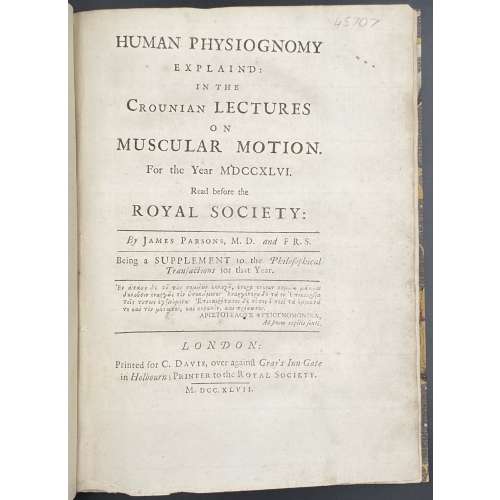 HUMAN PHYSIOGNOMY | EXPLAIN'D: | IN THE | Crounian LECTURES | ON MUSCULAR MOTION. | For the Year MDCCXLVI. | Read before the | ROYAL SOCIETY: | By James Parsons, M.D. and F.R.S. | Being a SUPPLEMENT to the Philosophical | Transactions for that Year. | {Citation in the Greek from Aristotle, 6 lines} | LONDON: | Printed for C. Davis, over against Gray's Inn Gate | in Holbourn; Printer to the Royal Society. | M. DCC. XLVII. || Pagination: [4] i-viii [8] 1-82 [4]; collation: 4to; [a]4 b4 c2 <inset> B-L4 M3, wanting 1 leaf with An Index For the Lectures of the Years 1744, and 1745; Inset: 5 folding plates engraved by J. Mynde after J. Parsons ('I. Ps. MD del.'). Page 22.5 x 16.5 cm; plates 22.5 x 34 cm. Printed on laid paper, with tall "s". Binding: 23 x 17 cm, modern hardcover in marbled paper, modern endpapers, white paper label with black lettering to spine. Crounian Lectures (i.e. Croonian Lectures), named after William Croone (British, 1633 – 1684). Contributors: James Parsons (British, 1705 – 1770). James Mynde (British, 1702 – 1771). Davis, Printer to the Royal Society of London (British, 1665 – 1775). Ref.: Royal Academy, The Royal Society, Wellcome Collection.
HUMAN PHYSIOGNOMY | EXPLAIN'D: | IN THE | Crounian LECTURES | ON MUSCULAR MOTION. | For the Year MDCCXLVI. | Read before the | ROYAL SOCIETY: | By James Parsons, M.D. and F.R.S. | Being a SUPPLEMENT to the Philosophical | Transactions for that Year. | {Citation in the Greek from Aristotle, 6 lines} | LONDON: | Printed for C. Davis, over against Gray's Inn Gate | in Holbourn; Printer to the Royal Society. | M. DCC. XLVII. || Pagination: [4] i-viii [8] 1-82 [4]; collation: 4to; [a]4 b4 c2 <inset> B-L4 M3, wanting 1 leaf with An Index For the Lectures of the Years 1744, and 1745; Inset: 5 folding plates engraved by J. Mynde after J. Parsons ('I. Ps. MD del.'). Page 22.5 x 16.5 cm; plates 22.5 x 34 cm. Printed on laid paper, with tall "s". Binding: 23 x 17 cm, modern hardcover in marbled paper, modern endpapers, white paper label with black lettering to spine. Crounian Lectures (i.e. Croonian Lectures), named after William Croone (British, 1633 – 1684). Contributors: James Parsons (British, 1705 – 1770). James Mynde (British, 1702 – 1771). Davis, Printer to the Royal Society of London (British, 1665 – 1775). Ref.: Royal Academy, The Royal Society, Wellcome Collection. -
 Two volumes, 16.6 x 11.4 cm each, uniformly bound in sprinkled calf, spine with raised bands, gilt in compartments, with crimson and black gilt lettered labels. Ink inscription to title page of vol. 1: “Thomas Fry. St: John's, Oxford.” Vol. 1: Collation: 4to; π2 ✶2 a4 b3 A-Z4 2A-2E4 2F1, (total 124 leaves), plus frontispiece, 29 in-text vignettes. Pagination: [2] – h.t., [2] – t.p., [4] – preface, [i] ii-xiv – Vie de La Fontaine, [1] 2-224, [2] – table, (total 248 pages), ils. Vol. 2: Collation: 4to; π2 ✶3 A-Z4 2A-2K4 2L3, (total 140 leavs), 40 in-text vignettes. Pagination: [2] – h.t., [2] – t.p., [6] – preface, [1] 2-268, [2] – table, (total 280 pages), ils. Illustrations: frontispiece by Lebas (signature erased), Vie de La Fontaine headpiece by Fessard after Cochin, 2 fleurons on two title pages, 69 vignettes by Chedel, Fessard, and Ravenet after Cochin (not signed). Catalogue raisonné: Lewine: 278; Cohen-deRicci: 557-8. Contributors: Charles-Nicolas Cochin (French, 1715 – 1790) – artist. Engravers: Pierre Quentin Chedel (French, 1705 – 1763). Étienne Fessard (French, 1714 – 1774). Simon François Ravenet (French, 1706 – 1764). Jacques-Philippe Le Bas [Lebas] (French, 1707 – 1783). Provenance: Thomas Fry (British, 1718 – 1772) – English priest and academic, president of St John's College, Oxford from 1757.
Two volumes, 16.6 x 11.4 cm each, uniformly bound in sprinkled calf, spine with raised bands, gilt in compartments, with crimson and black gilt lettered labels. Ink inscription to title page of vol. 1: “Thomas Fry. St: John's, Oxford.” Vol. 1: Collation: 4to; π2 ✶2 a4 b3 A-Z4 2A-2E4 2F1, (total 124 leaves), plus frontispiece, 29 in-text vignettes. Pagination: [2] – h.t., [2] – t.p., [4] – preface, [i] ii-xiv – Vie de La Fontaine, [1] 2-224, [2] – table, (total 248 pages), ils. Vol. 2: Collation: 4to; π2 ✶3 A-Z4 2A-2K4 2L3, (total 140 leavs), 40 in-text vignettes. Pagination: [2] – h.t., [2] – t.p., [6] – preface, [1] 2-268, [2] – table, (total 280 pages), ils. Illustrations: frontispiece by Lebas (signature erased), Vie de La Fontaine headpiece by Fessard after Cochin, 2 fleurons on two title pages, 69 vignettes by Chedel, Fessard, and Ravenet after Cochin (not signed). Catalogue raisonné: Lewine: 278; Cohen-deRicci: 557-8. Contributors: Charles-Nicolas Cochin (French, 1715 – 1790) – artist. Engravers: Pierre Quentin Chedel (French, 1705 – 1763). Étienne Fessard (French, 1714 – 1774). Simon François Ravenet (French, 1706 – 1764). Jacques-Philippe Le Bas [Lebas] (French, 1707 – 1783). Provenance: Thomas Fry (British, 1718 – 1772) – English priest and academic, president of St John's College, Oxford from 1757. -
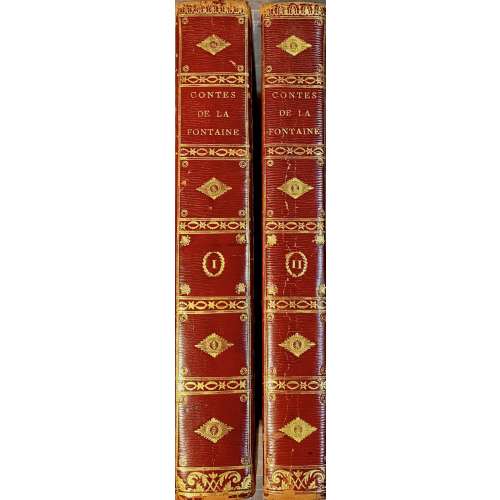 Two-volume large paper edition with 20 plates in two states. Vol. 1 (with plates). Title : CONTES | ET | NOUVELLES EN VERS. | PAR | JEAN DE LA FONTAINE. | — | TOME PREMIER| {vignette “P.P. Choffard 95”} | A PARIS, | DE L’IMPRIMERIE DE P. DIDOT L'AÎNÉ. | L’AN III DE LA RÉPUBLIQUE. | M. DCC. XCV. || Pagination: [2] [i-iv] v-vii [viii], 1-280 [2 table] [2], total 294 pages, ils. Collation: 4to; 1 blank, π4 (π3a signed “a”), 1-354 361, 1 blank, total 147 leaves, plus 40 leaves of plates with tissue guards, after Fragonard and others, which represent 20 engravings, each in two states, before and after letters, besides №9 (Le Calendrier des Vieillards by Jean Dambrun after Fragonard), which has two identical copies, both before letters. Vol. 2. (without plates) Title: same, but TOME SECOND. Pagination: [2] [4] 1-334 [2], total 342 pages. Collation: 4to; 1 blank, π2 1-414 423 1 blank, total 167 leaves. Binding: Two volumes uniformly bound in crimson straight-grain morocco, ruled in gilt, gilt-decorated flat spine with lettering, board edges and turn-ins tooled with gilt dentelles, marbled endpapers, three bookplates to front pastedown, top edge trimmed, 2nd volume partly uncut; text and plates printed on thick Dutch wove paper. Size: volumes: 33.3 x 25.2 cm; leaves: 31.5 x 23.5 cm. Provenance: Bishop, Cortlandt Field (American, 1870 – 1935) – bookplate. Mary S. Collins – bookplate by J. H. Fincken. Robin F. Satinsky (American, 1919 – 2008) – Robin Collection bookplate. Catalogue raisonné: Ray (French): 133-137; Cohen-DeRicci 573-582 ; Lewine : 281-282. CONTRIBUTORS: Jean de La Fontaine (French, 1621–1695) – author. Pierre Didot (French, 1761–1853) – publisher, printer. Artists: Jean-Honoré Fragonard (French, 1732–1806) Jean Baptiste Mallet (French, 1759–1835) Jacques Louis François Touzé (French, 1747–1807) Charles Monnet (French, 1732–after 1808) Engravers: Jacques Aliamet (French, 1726–1788) Jean Dambrun (French, 1741–about 1808) Jean Louis Delignon (French, 1755–about 1804) Jean Baptiste Michel Dupréel (French, active 1787–1817) Louis Michel Halbou (French, 1730–1809) Charles Louis Lingée (French, 1748–1819) Charles Emmanuel Jean Baptiste Patas (French, 1744–1802) Jean Baptiste Simonet (French, 1742–1813) Jean Baptiste Tilliard (French, 1740–1823) Philippe Trière (French, 1756–about 1815) Pierre-Philippe Choffard (French, 1730–1809) – t.p. vignette PLATES (collation order): №8: Fragonard / Trière – La Gageure des trois Commères №1*: Fragonard / Lingée – Joconde №1**: Mallet / Trière – Joconde №2: Fragonard / Delignon – Le Cocu battu et content №3: Fragonard / Tilliard – Le Mari confesseur №4: Fragonard / Dambrun – Le Savetier №5: Fragonard / Lingée – Le Paysan qui avait offensé son Seigneur №9: Fragonard / Dambrun – Le Calendrier des Vieillards №10: Fragonard / Aliamet – A Femme avare galant Escroc №12: Fragonard / Halbou – Le Gascon puni №11: Fragonard / Patas – On ne s’avise jamais de tout №13: Monnet / Tilliard – La Fiancée du roi de Garbe №14: Fragonard / Dupréel – La Coupe enchantée №15: Fragonard / Tilliard – Le Faucon №17: Fragonard / Patas – Le Pâté d’Anguilles №18: Fragonard / Tilliard – Le Magnifique №19: Fragonard / Delignon – La Matrone d’Ephèse №20: Fragonard / Patas – Belphégor №22: Touzé / Simonet – Le Glouton №26: Touzé / Lingée – Le Baiser rendu
Two-volume large paper edition with 20 plates in two states. Vol. 1 (with plates). Title : CONTES | ET | NOUVELLES EN VERS. | PAR | JEAN DE LA FONTAINE. | — | TOME PREMIER| {vignette “P.P. Choffard 95”} | A PARIS, | DE L’IMPRIMERIE DE P. DIDOT L'AÎNÉ. | L’AN III DE LA RÉPUBLIQUE. | M. DCC. XCV. || Pagination: [2] [i-iv] v-vii [viii], 1-280 [2 table] [2], total 294 pages, ils. Collation: 4to; 1 blank, π4 (π3a signed “a”), 1-354 361, 1 blank, total 147 leaves, plus 40 leaves of plates with tissue guards, after Fragonard and others, which represent 20 engravings, each in two states, before and after letters, besides №9 (Le Calendrier des Vieillards by Jean Dambrun after Fragonard), which has two identical copies, both before letters. Vol. 2. (without plates) Title: same, but TOME SECOND. Pagination: [2] [4] 1-334 [2], total 342 pages. Collation: 4to; 1 blank, π2 1-414 423 1 blank, total 167 leaves. Binding: Two volumes uniformly bound in crimson straight-grain morocco, ruled in gilt, gilt-decorated flat spine with lettering, board edges and turn-ins tooled with gilt dentelles, marbled endpapers, three bookplates to front pastedown, top edge trimmed, 2nd volume partly uncut; text and plates printed on thick Dutch wove paper. Size: volumes: 33.3 x 25.2 cm; leaves: 31.5 x 23.5 cm. Provenance: Bishop, Cortlandt Field (American, 1870 – 1935) – bookplate. Mary S. Collins – bookplate by J. H. Fincken. Robin F. Satinsky (American, 1919 – 2008) – Robin Collection bookplate. Catalogue raisonné: Ray (French): 133-137; Cohen-DeRicci 573-582 ; Lewine : 281-282. CONTRIBUTORS: Jean de La Fontaine (French, 1621–1695) – author. Pierre Didot (French, 1761–1853) – publisher, printer. Artists: Jean-Honoré Fragonard (French, 1732–1806) Jean Baptiste Mallet (French, 1759–1835) Jacques Louis François Touzé (French, 1747–1807) Charles Monnet (French, 1732–after 1808) Engravers: Jacques Aliamet (French, 1726–1788) Jean Dambrun (French, 1741–about 1808) Jean Louis Delignon (French, 1755–about 1804) Jean Baptiste Michel Dupréel (French, active 1787–1817) Louis Michel Halbou (French, 1730–1809) Charles Louis Lingée (French, 1748–1819) Charles Emmanuel Jean Baptiste Patas (French, 1744–1802) Jean Baptiste Simonet (French, 1742–1813) Jean Baptiste Tilliard (French, 1740–1823) Philippe Trière (French, 1756–about 1815) Pierre-Philippe Choffard (French, 1730–1809) – t.p. vignette PLATES (collation order): №8: Fragonard / Trière – La Gageure des trois Commères №1*: Fragonard / Lingée – Joconde №1**: Mallet / Trière – Joconde №2: Fragonard / Delignon – Le Cocu battu et content №3: Fragonard / Tilliard – Le Mari confesseur №4: Fragonard / Dambrun – Le Savetier №5: Fragonard / Lingée – Le Paysan qui avait offensé son Seigneur №9: Fragonard / Dambrun – Le Calendrier des Vieillards №10: Fragonard / Aliamet – A Femme avare galant Escroc №12: Fragonard / Halbou – Le Gascon puni №11: Fragonard / Patas – On ne s’avise jamais de tout №13: Monnet / Tilliard – La Fiancée du roi de Garbe №14: Fragonard / Dupréel – La Coupe enchantée №15: Fragonard / Tilliard – Le Faucon №17: Fragonard / Patas – Le Pâté d’Anguilles №18: Fragonard / Tilliard – Le Magnifique №19: Fragonard / Delignon – La Matrone d’Ephèse №20: Fragonard / Patas – Belphégor №22: Touzé / Simonet – Le Glouton №26: Touzé / Lingée – Le Baiser rendu -
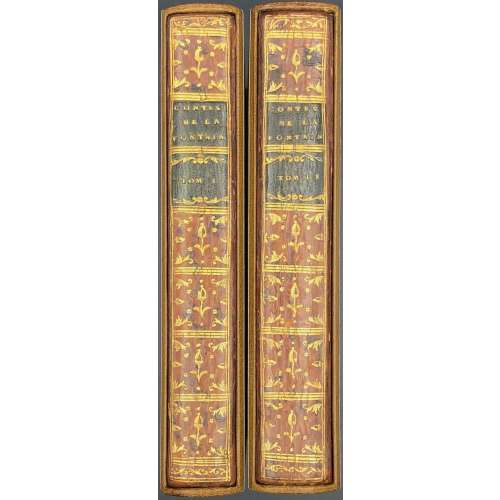 Two-volume edition, financed, arranged and managed by Fermiers généraux. Vol. 1. Title : CONTES | ET | NOUVELLES | EN VERS, | Par M. de La Fontaine. | TOME I. | {vignette} | A AMSTERDAM. | — | M. DCC. LXII. || Pagination: [2] – blanks [i, ii] – h.t. / blank, [iii, iv] – t.p. / blank, v-xiv, [1] 2–268 [269-70] – table, [4] – blanks, plus frontispiece by Fiquet after Rigault, t.p. vignette, vignette, headpiece, and 23 tailpieces by Choffard, 39 plates by various engravers after Charles Eisen. Vol. 2. Title: same but TOME II. Pagination: [2] – blanks] [i, ii] – h.t. / blank, [iii] iv-viii [1] 2–306 [307-10] – épitaphe / table, [4] – blanks, plus frontispiece by Fiquet after Vispré, t.p. vignette, vignette, headpiece, and 29 tailpieces by Choffard, and 42 plates after Charles Eisen (Ray only cite 41 plates). Binding: 2 volumes, 19.8 x 12.2 each, uniformly bound in full Spanish mottled calf, boards triple ruled in gilt, flat spine with triple bands, double ruled and tooled in gilt, black title labels lettered in gilt, all margins gilt, marbled end-papers, in cardboard slipcases, openings leathered. In vol. 1 a manuscript plate 4.8 x 8.2 cm pasted to page [1]: "Cette Édition est très rare n’y ayant | eu que 30 Exemplaires de livres, ou la figure principale dans le Cas de Conscience page 143 Tom 2 est nud tandis que dans les autres Éditions cette Figure est voilée par un feuillage".
Two-volume edition, financed, arranged and managed by Fermiers généraux. Vol. 1. Title : CONTES | ET | NOUVELLES | EN VERS, | Par M. de La Fontaine. | TOME I. | {vignette} | A AMSTERDAM. | — | M. DCC. LXII. || Pagination: [2] – blanks [i, ii] – h.t. / blank, [iii, iv] – t.p. / blank, v-xiv, [1] 2–268 [269-70] – table, [4] – blanks, plus frontispiece by Fiquet after Rigault, t.p. vignette, vignette, headpiece, and 23 tailpieces by Choffard, 39 plates by various engravers after Charles Eisen. Vol. 2. Title: same but TOME II. Pagination: [2] – blanks] [i, ii] – h.t. / blank, [iii] iv-viii [1] 2–306 [307-10] – épitaphe / table, [4] – blanks, plus frontispiece by Fiquet after Vispré, t.p. vignette, vignette, headpiece, and 29 tailpieces by Choffard, and 42 plates after Charles Eisen (Ray only cite 41 plates). Binding: 2 volumes, 19.8 x 12.2 each, uniformly bound in full Spanish mottled calf, boards triple ruled in gilt, flat spine with triple bands, double ruled and tooled in gilt, black title labels lettered in gilt, all margins gilt, marbled end-papers, in cardboard slipcases, openings leathered. In vol. 1 a manuscript plate 4.8 x 8.2 cm pasted to page [1]: "Cette Édition est très rare n’y ayant | eu que 30 Exemplaires de livres, ou la figure principale dans le Cas de Conscience page 143 Tom 2 est nud tandis que dans les autres Éditions cette Figure est voilée par un feuillage".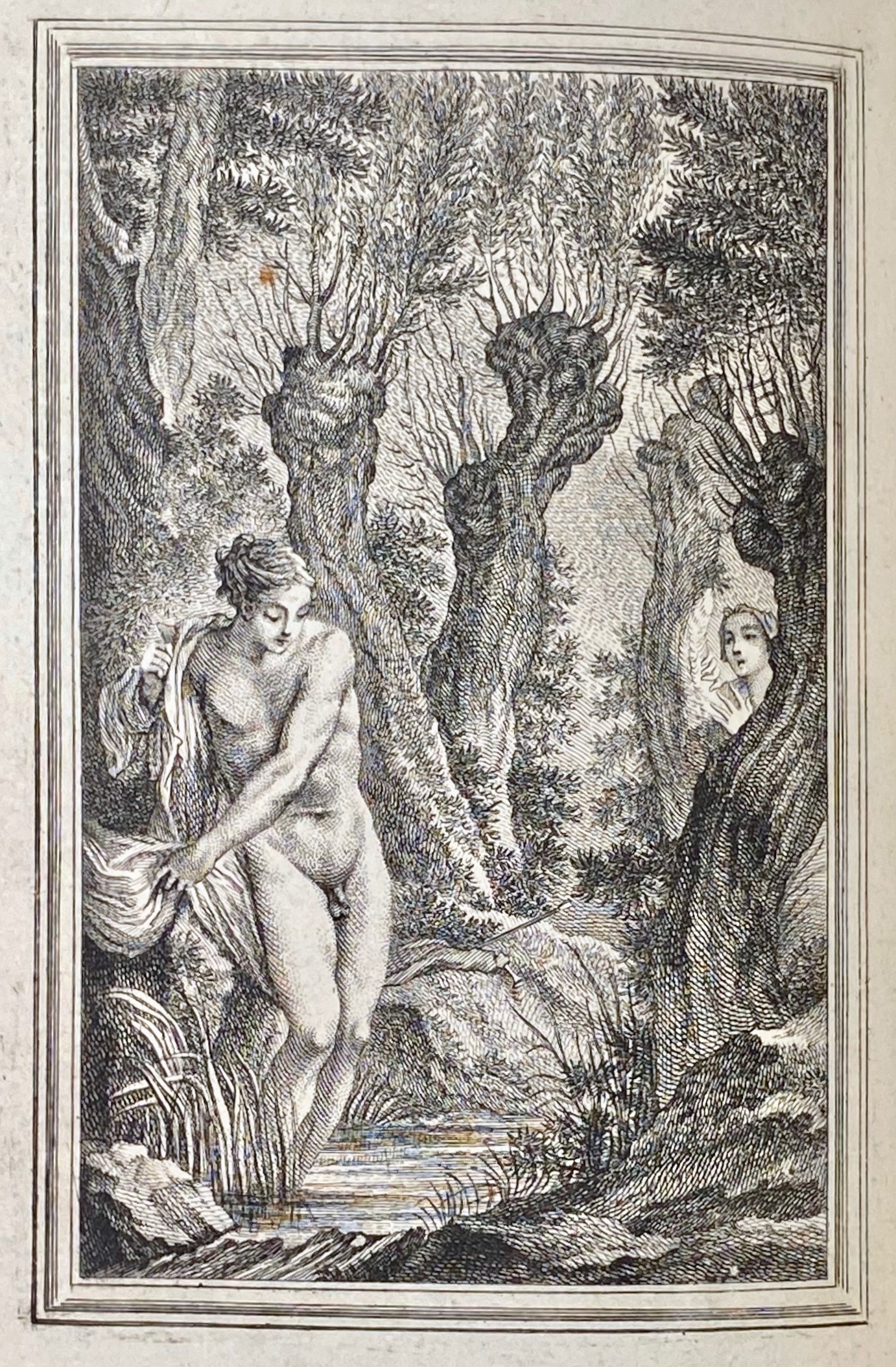
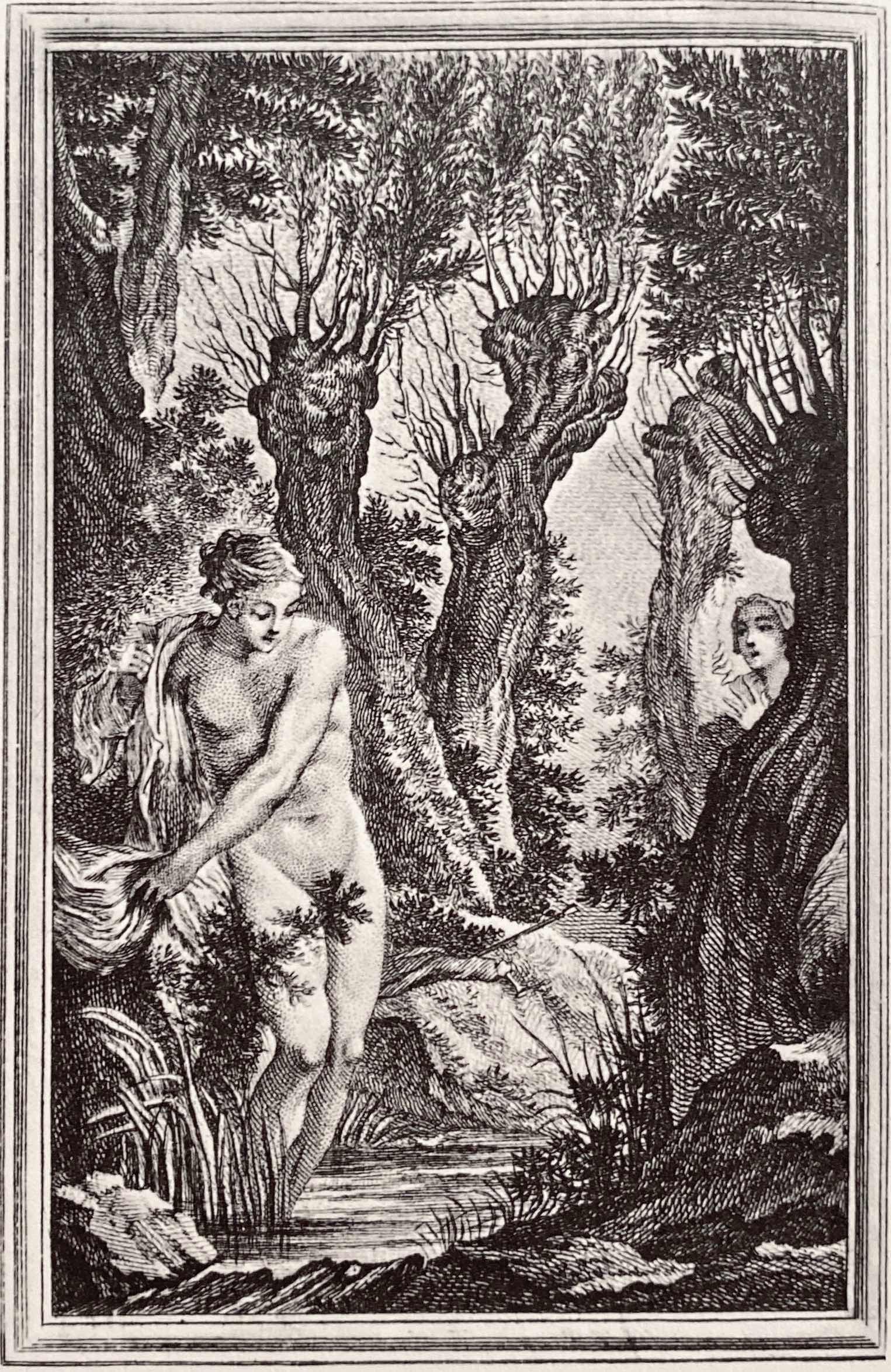 Contributors:
Jean de La Fontaine (French, 1621–1695) – author.
Fermiers généraux and Jean Baptiste Séroux d'Agincourt (French, 1730 – 1814) – publisher.
Joseph Gérard Barbou (French, 1723–1790) – printer.
Artists:
Charles Eisen (French, 1720 – 1778)
François Xavier Vispré (British-French, c.1730 – 1789 or after)
Hyacinthe Rigaud [Jacint Rigau-Ros i Serra] (Catalan-French, 1659 – 1743)
Engravers:
Joseph de Longueil (French, 1730 – 1792)
Noël Le Mire (French, 1724 – 1801)
Jean-Jacques André Le Veau (French, 1729 – 1786)
Jacques Aliamet (French, 1726 – 1788)
Jean Charles Baquoy (French, 1721 – 1777)
Pierre-Philippe Choffard (French, 1730 – 1809)
Jean Jacques Flipart (French, 1719 – 1782)
Louis Simon Lempereur (French, 1725 – 1796)
Jean Ouvrier (French, 1725 – 1784)
Contributors:
Jean de La Fontaine (French, 1621–1695) – author.
Fermiers généraux and Jean Baptiste Séroux d'Agincourt (French, 1730 – 1814) – publisher.
Joseph Gérard Barbou (French, 1723–1790) – printer.
Artists:
Charles Eisen (French, 1720 – 1778)
François Xavier Vispré (British-French, c.1730 – 1789 or after)
Hyacinthe Rigaud [Jacint Rigau-Ros i Serra] (Catalan-French, 1659 – 1743)
Engravers:
Joseph de Longueil (French, 1730 – 1792)
Noël Le Mire (French, 1724 – 1801)
Jean-Jacques André Le Veau (French, 1729 – 1786)
Jacques Aliamet (French, 1726 – 1788)
Jean Charles Baquoy (French, 1721 – 1777)
Pierre-Philippe Choffard (French, 1730 – 1809)
Jean Jacques Flipart (French, 1719 – 1782)
Louis Simon Lempereur (French, 1725 – 1796)
Jean Ouvrier (French, 1725 – 1784)
Étienne Ficquet (French 1719 – 1794)
Catalogue raisonné: Ray (French): №26, pp. 54-56; Cohen-DeRicci: 558-571; Lewine: 278-280. -
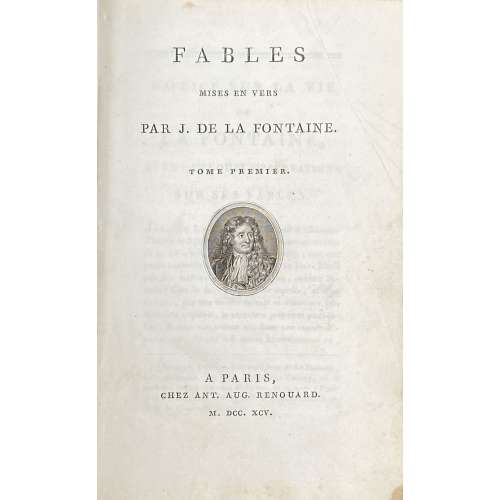 Two 8vo volumes bound in one, 19 x 12.5 cm, in full mottled sheepskin with gilt-bordered boards, gilt decorated flat spine with gilt-lettered red and black calf labels, rebacked, marbled endpapers and edges, printed on wove paper, plates on thicker laid paper. Title-page: FABLES | MISES EN VERS | PAR J. DE LA FONTAINE. | TOME PREMIER (SECOND). | {medallion portrait} (printer’s device “PC”) | A PARIS, | CHEZ ANT. AUG. RENOUARD. | M. DCC. XCV. || Collation: Vol. 1: π2 (h.t./imprint, t.p. medallion portrait/blank), [1]-38 (Notice sur la vie…), 1-58 64 (Vie de la Fontaine, Épitre, Préface, Vie d’Ésope), [7]-148 156 χ3 (table); pagination [4] [i] ii-xlviii, [1] 2-234. Total 143 leaves (286 pages) plus 6 plates after Moreau le Jeune by Devilliers fratres (p. 112), E. De Ghendt (pp. 122 and 181), Jean Louis Delignon (p. 140), Delvaux (p. 197), and Ph. Trière (p. 219). Title medallion portrait of La Fontaine (G Rigault pinx. – C S Gaucher inc.) by Gaucher after Rigaud. Vol. 2: π2 1-158 164; pagination [4] [1] 2-247 [248 blank]. Total 126 leaves (252 pages) plus 6 plates after Moreau le Jeune by Devilliers fratres (p. 19), Villerey (pp. 37, 80, and 146), Bosq (p. 121), and Ph. Trière (p. 199). The book published in 1795 (An 3) supplemented with plates produced in 1811 and 1812 for Œuvres complèttes (sic) de Jean de la Fontaine published by Lefèvre in 1814. The reason for choosing this particular edition for someone's library shortly after 1814 was probably the absence of censorship in 1795. Catalogue raisonné: (1) Lewine [LIB-2538.2020] on p. 276 (Paris, chez Renouard, 1795, 2 vols., 8vo., medal portrait on first title, and 12 plates after Moreau by Delvaux, Bosq, Ghendt, Trière, and Villerey). (2) M.-J.-F. Mahérault. L' oeuvre de Moreau le Jeune : catalogue raisonné et descriptif avec notes iconographiques et bibliographiques. — Paris: A. Labitte, 1880. Contributors: Jean de La Fontaine (French, 1621–1695) – author. Jean-Michel Moreau le Jeune (French, 1741–1814) – artist. Hyacinthe Rigaud (French, 1659 – 1743) – artist. Antoine-Augustin Renouard (French, 1765 – 1853) – publisher. Pierre Causse (French, 1761 – 1834) – printer. Engravers: Charles Étienne Gaucher (French, 1741 – 1804) Etienne De Villiers [Devilliers, Devilliers fratres] (French, 1784 – after 1844) Emmanuel Jean Nepomucène de Ghendt (Flemish, worked in France, 1738 – 1815) Jean-Louis Delignon (French, 1755 – 1820) Rémi Henri Joseph Delvaux (French, 1748 – 1823) Philippe Trière (French, 1756 – c. 1815) Auguste Villerey (French, 1801 – 1846) Jean Bosq (French, fl. c. 1801 – 1844)
Two 8vo volumes bound in one, 19 x 12.5 cm, in full mottled sheepskin with gilt-bordered boards, gilt decorated flat spine with gilt-lettered red and black calf labels, rebacked, marbled endpapers and edges, printed on wove paper, plates on thicker laid paper. Title-page: FABLES | MISES EN VERS | PAR J. DE LA FONTAINE. | TOME PREMIER (SECOND). | {medallion portrait} (printer’s device “PC”) | A PARIS, | CHEZ ANT. AUG. RENOUARD. | M. DCC. XCV. || Collation: Vol. 1: π2 (h.t./imprint, t.p. medallion portrait/blank), [1]-38 (Notice sur la vie…), 1-58 64 (Vie de la Fontaine, Épitre, Préface, Vie d’Ésope), [7]-148 156 χ3 (table); pagination [4] [i] ii-xlviii, [1] 2-234. Total 143 leaves (286 pages) plus 6 plates after Moreau le Jeune by Devilliers fratres (p. 112), E. De Ghendt (pp. 122 and 181), Jean Louis Delignon (p. 140), Delvaux (p. 197), and Ph. Trière (p. 219). Title medallion portrait of La Fontaine (G Rigault pinx. – C S Gaucher inc.) by Gaucher after Rigaud. Vol. 2: π2 1-158 164; pagination [4] [1] 2-247 [248 blank]. Total 126 leaves (252 pages) plus 6 plates after Moreau le Jeune by Devilliers fratres (p. 19), Villerey (pp. 37, 80, and 146), Bosq (p. 121), and Ph. Trière (p. 199). The book published in 1795 (An 3) supplemented with plates produced in 1811 and 1812 for Œuvres complèttes (sic) de Jean de la Fontaine published by Lefèvre in 1814. The reason for choosing this particular edition for someone's library shortly after 1814 was probably the absence of censorship in 1795. Catalogue raisonné: (1) Lewine [LIB-2538.2020] on p. 276 (Paris, chez Renouard, 1795, 2 vols., 8vo., medal portrait on first title, and 12 plates after Moreau by Delvaux, Bosq, Ghendt, Trière, and Villerey). (2) M.-J.-F. Mahérault. L' oeuvre de Moreau le Jeune : catalogue raisonné et descriptif avec notes iconographiques et bibliographiques. — Paris: A. Labitte, 1880. Contributors: Jean de La Fontaine (French, 1621–1695) – author. Jean-Michel Moreau le Jeune (French, 1741–1814) – artist. Hyacinthe Rigaud (French, 1659 – 1743) – artist. Antoine-Augustin Renouard (French, 1765 – 1853) – publisher. Pierre Causse (French, 1761 – 1834) – printer. Engravers: Charles Étienne Gaucher (French, 1741 – 1804) Etienne De Villiers [Devilliers, Devilliers fratres] (French, 1784 – after 1844) Emmanuel Jean Nepomucène de Ghendt (Flemish, worked in France, 1738 – 1815) Jean-Louis Delignon (French, 1755 – 1820) Rémi Henri Joseph Delvaux (French, 1748 – 1823) Philippe Trière (French, 1756 – c. 1815) Auguste Villerey (French, 1801 – 1846) Jean Bosq (French, fl. c. 1801 – 1844) -
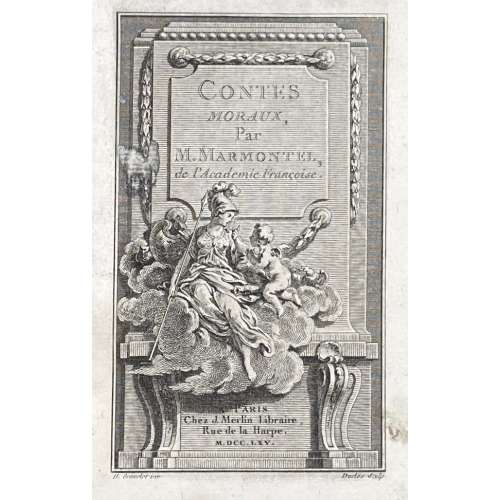 Engraved title-page: Contes | Moraux | Par | M. Marmontel, | de l'Academie Françoise. | A Paris | Chez J. Merlin Libraire, | Rue de la Harpe, | M DCC LXV ||Description: 3 volumes, 8vo, 20.4 x 13 cm, first issue, bound in the contemporary speckled calf, all edges gilt, spines gilt with double red/brown lettering labels (vol 1. labels missing); raised bands, gilt in compartments, double gilt-ruled borders; marbled endpapers. With the contemporary signature in each volume of Caroline Marlborough of Blenheim Palace, and bookplates of Lord F. A. Spencer. This is certainly Lady Caroline Russell, wife of George Spencer, Fourth Duke of Marlborough; she was daughter to the Duke of Bedford and was married in 1762. She died at Blenheim in 1811. The later bookplate in each volume pasted to the front pastedown of her son Francis Almeric Spencer (British, 1779-1845). Pagination: Vol. I: [two blank leaves] [half-title, verso blank] [recto blank, frontispiece on verso: portrait of Marmontel by St. Aubin after Cochin] [engraved t.p. by Duclos after Gravelot, verso blank], [i] ii-xvi, [table des contes with 5-line Errata (autograph Lordine Marlborough), verso blank], [1] 2–345 [346-50 blanks]; 9 plates after Gravelot by: Baquoy, de Longueil (2), Legrand, Leveau (2), Rousseau, Voyez, and unsigned (1). Vol. 2: [two blank leaves] [half-title, verso blank] [engraved t.p. by Duclos after Gravelot, verso blank] [table des contes with 10-line Errata (autograph Lordine Marlborough), verso blank], [1] 2–376 [377-50 blanks]; 9 plates after Gravelot by: de Longueil (5), Leveau (2), Pasquier and Rousseau. Vol. 3: [two blank leaves] [half-title, verso blank] [engraved t.p. by Duclos after Gravelot, verso blank] [table des contes with 9-line Errata, verso blank] [two leaves: approbation and Privilege du Roi] [1] 2–312 [313-16 blanks]; 5 plates after Gravelot by: de Longueil (2), Le Mire (2), and Pasquier. Catalogue raisonné: Cohen-De Ricci 686-7; Gordon N. Ray. The Art of the French Illustrated Book 1700 to 1914. — NY, London: The Pierpont Morgan Library; Cornell University Press, 1982, Vol. 1. pp. 44-5. [In their copy vol. 2 and 3 in a different order]; MFA ACCESSION NUMBER 37.1488a-c Illustrated by: Hubert François Gravelot (French, 1699–1773) Engraved by: Jean Charles Baquoy (French, 1721–1777) Engraved by: Antoine Jean Duclos (French, 1742–1795) Engraved by: Louis Legrand (French, 1723–1807) Engraved by: Noël Le Mire (French, 1724–1801) Engraved by: Jean Jacques André Le Veau (French, 1729–1785) Engraved by: Joseph de Longueil (French, 1730–1792) Engraved by: Jean Jacques Pasquier (French, died in 1785) Engraved by: Jean François Rousseau (French, born in 1740) Engraved by: Nicolas Joseph Voyez l'ainé (French, 1742–1806) Portrait(s) designed by: Charles-Nicolas Cochin le fils (French, 1715–1790) Engraved by: Augustin de Saint-Aubin (French, 1736–1807) Author: Jean-François Marmontel (French, 1723–1799) Publisher: Joseph Merlin (French, 1718–1783) Printer: Pierre-Alexandre Le Prieur (French, born in 1722)
Engraved title-page: Contes | Moraux | Par | M. Marmontel, | de l'Academie Françoise. | A Paris | Chez J. Merlin Libraire, | Rue de la Harpe, | M DCC LXV ||Description: 3 volumes, 8vo, 20.4 x 13 cm, first issue, bound in the contemporary speckled calf, all edges gilt, spines gilt with double red/brown lettering labels (vol 1. labels missing); raised bands, gilt in compartments, double gilt-ruled borders; marbled endpapers. With the contemporary signature in each volume of Caroline Marlborough of Blenheim Palace, and bookplates of Lord F. A. Spencer. This is certainly Lady Caroline Russell, wife of George Spencer, Fourth Duke of Marlborough; she was daughter to the Duke of Bedford and was married in 1762. She died at Blenheim in 1811. The later bookplate in each volume pasted to the front pastedown of her son Francis Almeric Spencer (British, 1779-1845). Pagination: Vol. I: [two blank leaves] [half-title, verso blank] [recto blank, frontispiece on verso: portrait of Marmontel by St. Aubin after Cochin] [engraved t.p. by Duclos after Gravelot, verso blank], [i] ii-xvi, [table des contes with 5-line Errata (autograph Lordine Marlborough), verso blank], [1] 2–345 [346-50 blanks]; 9 plates after Gravelot by: Baquoy, de Longueil (2), Legrand, Leveau (2), Rousseau, Voyez, and unsigned (1). Vol. 2: [two blank leaves] [half-title, verso blank] [engraved t.p. by Duclos after Gravelot, verso blank] [table des contes with 10-line Errata (autograph Lordine Marlborough), verso blank], [1] 2–376 [377-50 blanks]; 9 plates after Gravelot by: de Longueil (5), Leveau (2), Pasquier and Rousseau. Vol. 3: [two blank leaves] [half-title, verso blank] [engraved t.p. by Duclos after Gravelot, verso blank] [table des contes with 9-line Errata, verso blank] [two leaves: approbation and Privilege du Roi] [1] 2–312 [313-16 blanks]; 5 plates after Gravelot by: de Longueil (2), Le Mire (2), and Pasquier. Catalogue raisonné: Cohen-De Ricci 686-7; Gordon N. Ray. The Art of the French Illustrated Book 1700 to 1914. — NY, London: The Pierpont Morgan Library; Cornell University Press, 1982, Vol. 1. pp. 44-5. [In their copy vol. 2 and 3 in a different order]; MFA ACCESSION NUMBER 37.1488a-c Illustrated by: Hubert François Gravelot (French, 1699–1773) Engraved by: Jean Charles Baquoy (French, 1721–1777) Engraved by: Antoine Jean Duclos (French, 1742–1795) Engraved by: Louis Legrand (French, 1723–1807) Engraved by: Noël Le Mire (French, 1724–1801) Engraved by: Jean Jacques André Le Veau (French, 1729–1785) Engraved by: Joseph de Longueil (French, 1730–1792) Engraved by: Jean Jacques Pasquier (French, died in 1785) Engraved by: Jean François Rousseau (French, born in 1740) Engraved by: Nicolas Joseph Voyez l'ainé (French, 1742–1806) Portrait(s) designed by: Charles-Nicolas Cochin le fils (French, 1715–1790) Engraved by: Augustin de Saint-Aubin (French, 1736–1807) Author: Jean-François Marmontel (French, 1723–1799) Publisher: Joseph Merlin (French, 1718–1783) Printer: Pierre-Alexandre Le Prieur (French, born in 1722) -
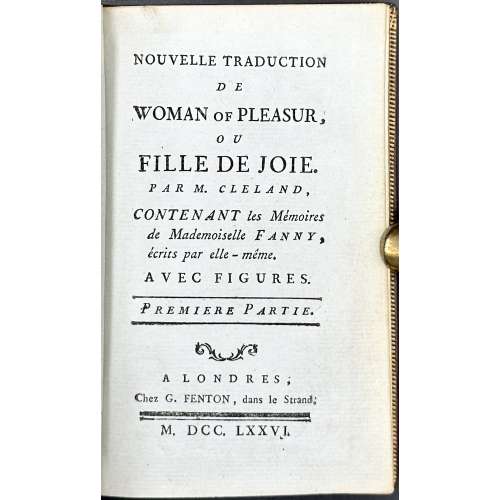 Hardcover volume, collated 18mo, 130 x 85 mm (2 parts in one). Contemporary burgundy morocco outlined with gilt triple fillet, flat spine gilt in compartments, brown morocco label gilt, all edges gilt, gilt dentelle, text printed on slightly blue laid paper with illegible watermark; dark blue endpapers, Tony Fekete (T. F.) bookplate by Wahorn to front pastedown. Frontispiece and 14 engraved plates by Elluin after Borel, with guard tissue. Graphite ms to h.t.: "Figures de Borrel. | Gravées pr. Elluin." Title-page: NOUVELLE TRADUCTION | DE | WOMAN OF PLEASUR, | OU | FILLE DE JOIE. | PAR M. CLELAND, | CONTENANT les Mémoires | de Mademoiselle FANNY, | écrits par elle – même. | AVEC FIGURES | — | PREMIERE (SECONDE) PARTIE. | — | ~ | A LONDRES; | Chez G. FENTON, dans le Strand; | — | M. DCC. LXXVI. || Collation: 18mo throughout A-O12/6, total 126 leaves plus 15 plates, incl. frontispiece. Pagination: separate for each part [1-5] 6-119 [120 blank], [1-3] 4-132, total 252 pages. Provenance: Tony Fekete (Christie’s 2014, № 54, p. 37; Price realized GBP 11,875): “[CLELAND, John (1709-1789).] Nouvelle traduction de Woman of Pleasur [sic] ou Fille de Joie. Contenant les Mémoires de Mademoiselle Fanny, écrits par elle-même. London [but Paris]: G. Fenton [Cazin], 1776. 2 volumes in one, duodecimo (128 x 80 mm). Printed on blue tinted paper. Frontispiece and 14 engraved plates on thick white paper by Elluin after Borel. (Short tear repaired in the margin of one plate, another plate with a faint dampstain touching the facing leaf of text.) Contemporary burgundy morocco, flat spine gilt in compartments, morocco label gilt, covers with a gilt triple fillet border, gilt edges, blue endpapers. THE MOST BEAUTIFUL 18TH-CENTURY ILLUSTRATED EDITION OF THIS CELEBRATED EROTIC NOVEL. An excellent copy bound in contemporary morocco. It is the second translation into French, but the first to include the exquisite plates by Elluin after Borel. These are some of the best illustrations by this remarkable partnership responsible for a number of important 18th-century libertine texts. Cohen-DeRicci 242-3; Dutel A-407 ; Gay-Lemonnyer II, 304; Pia Enfer, 915.” Catalogue raisonné: Dutel (I) A-407, p. 134; Cohen-DeRicci 242-3; Fekete (Christie's) 54, p. 37. Contributors: John Cleland (British, c. 1709 – 1789). François-Rolland Elluin (French, 1745 – c. 1822) Antoine Borel (French, 1743 – 1810) Hubert-Martin Cazin (French, 1724 – 1795) András Wahorn (Hungarian, b. 1953) Fekete, Tony Laszlo (Hungarian, b. 1972)
Hardcover volume, collated 18mo, 130 x 85 mm (2 parts in one). Contemporary burgundy morocco outlined with gilt triple fillet, flat spine gilt in compartments, brown morocco label gilt, all edges gilt, gilt dentelle, text printed on slightly blue laid paper with illegible watermark; dark blue endpapers, Tony Fekete (T. F.) bookplate by Wahorn to front pastedown. Frontispiece and 14 engraved plates by Elluin after Borel, with guard tissue. Graphite ms to h.t.: "Figures de Borrel. | Gravées pr. Elluin." Title-page: NOUVELLE TRADUCTION | DE | WOMAN OF PLEASUR, | OU | FILLE DE JOIE. | PAR M. CLELAND, | CONTENANT les Mémoires | de Mademoiselle FANNY, | écrits par elle – même. | AVEC FIGURES | — | PREMIERE (SECONDE) PARTIE. | — | ~ | A LONDRES; | Chez G. FENTON, dans le Strand; | — | M. DCC. LXXVI. || Collation: 18mo throughout A-O12/6, total 126 leaves plus 15 plates, incl. frontispiece. Pagination: separate for each part [1-5] 6-119 [120 blank], [1-3] 4-132, total 252 pages. Provenance: Tony Fekete (Christie’s 2014, № 54, p. 37; Price realized GBP 11,875): “[CLELAND, John (1709-1789).] Nouvelle traduction de Woman of Pleasur [sic] ou Fille de Joie. Contenant les Mémoires de Mademoiselle Fanny, écrits par elle-même. London [but Paris]: G. Fenton [Cazin], 1776. 2 volumes in one, duodecimo (128 x 80 mm). Printed on blue tinted paper. Frontispiece and 14 engraved plates on thick white paper by Elluin after Borel. (Short tear repaired in the margin of one plate, another plate with a faint dampstain touching the facing leaf of text.) Contemporary burgundy morocco, flat spine gilt in compartments, morocco label gilt, covers with a gilt triple fillet border, gilt edges, blue endpapers. THE MOST BEAUTIFUL 18TH-CENTURY ILLUSTRATED EDITION OF THIS CELEBRATED EROTIC NOVEL. An excellent copy bound in contemporary morocco. It is the second translation into French, but the first to include the exquisite plates by Elluin after Borel. These are some of the best illustrations by this remarkable partnership responsible for a number of important 18th-century libertine texts. Cohen-DeRicci 242-3; Dutel A-407 ; Gay-Lemonnyer II, 304; Pia Enfer, 915.” Catalogue raisonné: Dutel (I) A-407, p. 134; Cohen-DeRicci 242-3; Fekete (Christie's) 54, p. 37. Contributors: John Cleland (British, c. 1709 – 1789). François-Rolland Elluin (French, 1745 – c. 1822) Antoine Borel (French, 1743 – 1810) Hubert-Martin Cazin (French, 1724 – 1795) András Wahorn (Hungarian, b. 1953) Fekete, Tony Laszlo (Hungarian, b. 1972) -
 Iron tsuba of round form with design of hatchet executed in openwork (sukashi) and three fan panels motif on both sides carved in low relief (sukidashi-bori). Designs on the fan panels - face: bellflower, plum blossom in mist, grass leaves; - back: clouds, grass, and half plum blossom in mist. Copper sekigane. Koga-hitsu-ana probably cut out on a later date. Kamakura or kamakura-bori school. Edo period. Height: 83.8 mm, Width: 82.2 mm, Thickness at seppa-dai: 3.2 mm. NBTHK certificate № 4005500: Hozon (worthy of preservation).
Iron tsuba of round form with design of hatchet executed in openwork (sukashi) and three fan panels motif on both sides carved in low relief (sukidashi-bori). Designs on the fan panels - face: bellflower, plum blossom in mist, grass leaves; - back: clouds, grass, and half plum blossom in mist. Copper sekigane. Koga-hitsu-ana probably cut out on a later date. Kamakura or kamakura-bori school. Edo period. Height: 83.8 mm, Width: 82.2 mm, Thickness at seppa-dai: 3.2 mm. NBTHK certificate № 4005500: Hozon (worthy of preservation). -
 An unsigned print, presumably by Katsukawa Shunshō that presumably depicts a kabuki actor Ichikawa Monnosuke II. I was not able to find any reference of the image. Size: Hosoban. According to The actor's image. Print makers of the Katsukawa School. Timothy T. Clark and Osamu Ueda with Donald Jenkins. Naomi Noble Richard, editor The Art Institute of Chicago in association with Princeton University Press, 1994, Ichikawa Monnosuke II was born in 1743, in Ōji Takinogawa, Edo. He died on October 19, 1974. His specialities were young male roles (wakashu) and male leads (tachi yaku). He was considered to be one of the four best young actors of his day.
An unsigned print, presumably by Katsukawa Shunshō that presumably depicts a kabuki actor Ichikawa Monnosuke II. I was not able to find any reference of the image. Size: Hosoban. According to The actor's image. Print makers of the Katsukawa School. Timothy T. Clark and Osamu Ueda with Donald Jenkins. Naomi Noble Richard, editor The Art Institute of Chicago in association with Princeton University Press, 1994, Ichikawa Monnosuke II was born in 1743, in Ōji Takinogawa, Edo. He died on October 19, 1974. His specialities were young male roles (wakashu) and male leads (tachi yaku). He was considered to be one of the four best young actors of his day. -
 Katsukawa Shun'ei. Signed: Shun'ei ga (春英画). Vertical Ōban. No reference whatsoever. Unidentified play, actors, roles, year, theatre. SOLD
Katsukawa Shun'ei. Signed: Shun'ei ga (春英画). Vertical Ōban. No reference whatsoever. Unidentified play, actors, roles, year, theatre. SOLD -
 Print by Katsukawa Shun'ei that presumably depicts a kabuki actor Ichikawa Monnosuke II. I was not able to find any reference of the image. Size: Hosoban. SOLD
Print by Katsukawa Shun'ei that presumably depicts a kabuki actor Ichikawa Monnosuke II. I was not able to find any reference of the image. Size: Hosoban. SOLD -
 Katsukawa Shun'ei (勝川 春英; 1762 – 1819).TITLE: Sawamura Sôjûrô III as Kakogawa Honzô.SERIES: Kanadehon Chūshingura (Kana practice book: Treasury of the loyal retainers").DATE: 1795Signed: Shun'ei ga (春英画). Publisher: Iwatoya Kisaburō, Marks 173/p.169. Vertical Ōban: 14.75 x 9.625 inchOn 4th lunar month of 1795 Sôjûrô plays the roles of En'ya Hangan and Kakogawa Honzô in the drama "Kanadehon Chûshingura" at Miyakoza theater in Edo.
Katsukawa Shun'ei (勝川 春英; 1762 – 1819).TITLE: Sawamura Sôjûrô III as Kakogawa Honzô.SERIES: Kanadehon Chūshingura (Kana practice book: Treasury of the loyal retainers").DATE: 1795Signed: Shun'ei ga (春英画). Publisher: Iwatoya Kisaburō, Marks 173/p.169. Vertical Ōban: 14.75 x 9.625 inchOn 4th lunar month of 1795 Sôjûrô plays the roles of En'ya Hangan and Kakogawa Honzô in the drama "Kanadehon Chûshingura" at Miyakoza theater in Edo. -
 Artist: Katsukawa Shunkō [勝川 春好] (Japanese, 1743 – 1812).
Artist: Katsukawa Shunkō [勝川 春好] (Japanese, 1743 – 1812).Actor: Matsumoto Kōshirō IV [[松本幸四郎]; other names: Omegawa Kyōjūrō, Ichikawa Komazō II, Ichikawa Somegorô I, Ichikawa Takejūrō, Segawa Kinji, Segawa Kingo] (Japanese, 1737 – 1802).
Signed: Shunkō ga. Size: Hosoban; 14 x 33 cm. SOLD -
 Ichikawa Ebizō III (Matsumoto Kōshirō II, Ichikawa Danjūrō IV, 1711-1778) probably shown as Shinozuka Gorō in the Shibaraku scene of the play Ōyoroi Ebidō Shinozuka, performed at the Nakamura Theater in the 11th month of 1772 (Meiwa 9). This was the occasion when he celebrated his name change, from Matsumoto Kōshirō II to Ichikawa Ebizō III. The lobster or giant shrimp (ebi) upon the Ichikawa family crest (three concentric squares - three measures of rice) on his garment underscores the fact of the name change (ebizō).
Ichikawa Ebizō III (Matsumoto Kōshirō II, Ichikawa Danjūrō IV, 1711-1778) probably shown as Shinozuka Gorō in the Shibaraku scene of the play Ōyoroi Ebidō Shinozuka, performed at the Nakamura Theater in the 11th month of 1772 (Meiwa 9). This was the occasion when he celebrated his name change, from Matsumoto Kōshirō II to Ichikawa Ebizō III. The lobster or giant shrimp (ebi) upon the Ichikawa family crest (three concentric squares - three measures of rice) on his garment underscores the fact of the name change (ebizō). -
 Katsukawa Shunshō ( 勝川 春章; 1726 – 19 January 1793).
Katsukawa Shunshō ( 勝川 春章; 1726 – 19 January 1793).SIZE: 12.5 x 5.75 in.
-
 Katsukawa Shunshō ( 勝川 春章; 1726 – 19 January 1793).
Katsukawa Shunshō ( 勝川 春章; 1726 – 19 January 1793).Signed: Shunchô ga (春潮画); Censor's seal: kiwame (改印:極)
Publisher: Iwatoya Kisaburō (Eirindō); c. 1760s – 1832. Marks #173/p.169.
Reference: MFA ACCESSION NUMBER 11.21263. Not in Pins.
Act VII, Gion Ichiriki no ba ("The Ichiriki Teahouse at Gion") This act gives a taste of the bustling atmosphere of the Gion pleasure quarter in Kyoto. Yuranosuke is feigning a life of debauchery at the same teahouse to which Okaru has been indentured. Kudayū, the father of Sadakurō, arrives. He is now working for Moronō and his purpose is to discover whether Yuranosuke still plans revenge or not. He tests Yuranosuke's resolve by offering him food on the anniversary of their lord's death when he should be fasting. Yuranosuke is forced to accept. Yuranosuke's sword – the revered symbol of a samurai – is also found to be covered in rust. It would appear that Yuranosuke has no thoughts of revenge. But still unsure, Kudayū hides under the veranda. Now believing himself alone, Yuranosuke begins to read a secret letter scroll about preparations for the vendetta. On a higher balcony Okaru comes out to cool herself in the evening breeze and, noticing Yuranosuke close by, she also reads the letter reflected in her mirror. As Yuranosuke unrolls the scroll, Kudayū, too, examines the end which trails below the veranda. Suddenly, one of Okaru's hairpins drops to the floor and a shocked Yuranosuke quickly rolls up the scroll. Finding the end of the letter torn off, he realises that yet another person knows his secret and he must silence them both. Feigning merriment, he calls Okaru to come down and offers to buy out her contract. He goes off supposedly to fix the deal. Then Okaru's brother Heiemon enters and, hearing what has just happened, realises that Yuranosuke actually intends to keep her quiet by killing her. He persuades Okaru to let him kill her instead so as to save their honour and she agrees. Overhearing everything, Yuranosuke is now convinced of the pair's loyalty and stops them. He gives Okaru a sword and, guiding her hand, thrusts it through the floorboards to kill Kudayū. The main actor has to convey a wide variety of emotions between a fallen, drunkard rōnin and someone who in reality is quite different since he is only faking his weakness. This is called hara-gei or "belly acting", which means he has to perform from within to change characters. It is technically difficult to perform and takes a long time to learn, but once mastered the audience takes up on the actor's emotion. Emotions are also expressed through the colours of the costumes, a key element in kabuki. Gaudy and strong colours can convey foolish or joyful emotions, whereas severe or muted colours convey seriousness and focus. -
 Katsukawa Shunshō ( 勝川 春章; 1726 – 19 January 1793).
Katsukawa Shunshō ( 勝川 春章; 1726 – 19 January 1793).Signed: Katsukawa Shunshô ga (勝川春章画).
The size is somewhat larger than the standard pillar print (hashira-e): 16.3 x 67.7 cm.
No references found so far.
-
 The Seven Gods of Good Luck in the Takarabune (ship of fortune) with a crane (the phoenix) above them.
The Seven Gods of Good Luck in the Takarabune (ship of fortune) with a crane (the phoenix) above them.Attributed to Katsukawa Shunshō, fl. 1726–92. Publisher: Uemura from Shiba (Edo). Marks "Publishers": U361|25-300: Uemura han (1793-1813). Marks "Artists, publishers...": Emiya Kichiemon (1688-1835). Artist signature absent. Looks very much like Pins #565 [p.223], but NOT the same. This exact design has not been found anywhere.

-

Iron tsuba of circular form with a branch of loquat (biwa) pierced in positive silhouette (ji-sukashi) and carved in marubori technique (marubori-sukashi). Kozuka and kogai hitsu-ana are plugged with shakudo.
Signature: Choshu Kawaji ju Hisatsugu saku. Chōshū school in Nagato province.
According to M. Sesko 'Genealogies' Hisatsugu was a 4th generation Kawaji School master from Chōshū (present day Nagato), with the name Gonbei, formerly Toramatsu, adopted son of Tomohisa (1687-1743) [page 117]. For Tomohisa work see TSU-0104 in this collection. -
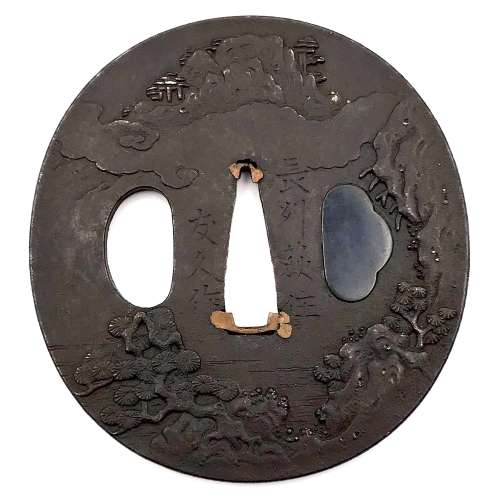
Iron tsuba of oval form carved with a landscape motif. Kogai-hitsu-ana plugged with shakudo. Sekigane of copper.
Signed: Chōshū Hagi-jū Tomohisa saku (長州萩住友久作).
Tomohisa, adopted son of Rokurō'emon, was 3rd generation master of Kawaji School from Hagi in Nagato (Chōshū), lived 1687-1743 [M. Sesko 'Genealogies', page 117].
Edo period, circa 1700. Dimensions: 71.1 x 66.8 x 2.9 mm For his adopted son Hisatsugu work see TSU-0103 in this collection. -
 Kikukawa Eizan (菊川 英山, 1787 – July 17, 1867) Signed: Eizan hitsu (英山筆)
Kikukawa Eizan (菊川 英山, 1787 – July 17, 1867) Signed: Eizan hitsu (英山筆)Jacob Pins #972/p.341. Leiden, Rijksmuseum voor Volkenkunde.
"The Lovers Miura-ya Komurasaki and Shirai Gonpachi: Tragic love stories taken from real life and dramatized were a staple of stage and print; the darkly romantic combination of desire and death was hugely popular in the eighteenth century. Hirai Gompachi was a warrior of the Tottori fief in western Japan who fled to Edo after committing a murder. He was apprehended and sentenced to death in 1679. His distraught lover, the courtesan Komurasaki, committed suicide at his grave." [MET]
.
-
 Santō Kyōden (山東 京伝, September 13, 1761 Edo – October 27, 1816) was a Japanese poet, writer and artist in the Edo period. He studied ukiyo-e under master Kitao Shigemasa (北尾 重政) [see SVJP-0006], and began illustrating kibyōshi under the pseudonym of Kitao Masanobu (北尾 政寅).
Santō Kyōden (山東 京伝, September 13, 1761 Edo – October 27, 1816) was a Japanese poet, writer and artist in the Edo period. He studied ukiyo-e under master Kitao Shigemasa (北尾 重政) [see SVJP-0006], and began illustrating kibyōshi under the pseudonym of Kitao Masanobu (北尾 政寅).Signed: Masunobu ga.
"Parody of the Nō Play Chōryō" (elsewhere) or "Parody of Huáng Shigōng and Zhāng Liáng" (David Waterhouse, The Harunobu Decade, Hotei Publishing, 2013, v. 2, №651). "The story [...] is about an encounter between the Chinese government minister Chôryô (Zhāng Liáng) and the legendary elder Kôsekikô (Huáng Shigōng) in the 3rd century BC. While riding a mule across a bridge, Kôsekikô dropped his sandal. Chôryô returned it to him. As a reward, Kôsekikô gave Chôryô a book of military strategy. Later, Chôryô helped to establish the Han Dynasty (207 BC-AD 220)." [The Walters Art Museum]References:
Waterhouse, The Harunobu Decade (2013), #651; Ukiyo-e shûka supp. 2 (1982), pl. 625; Pins, The Japanese Pillar Print (1982), #274/p.145; J. Kurth, Die Geschichte..., vol. II, Leipzig, 1928; S. Kikuchi, Ukiyo-e, 1966.
-
 Ebisu drawing wakamizu, the first water drawn from a well on the New Year. Kitao Shigemasa (北尾 重政, 1739 – 8 March 1820). Signed: Shigemasa. Publisher's mark: Nishimuraya Yohachi.
Ebisu drawing wakamizu, the first water drawn from a well on the New Year. Kitao Shigemasa (北尾 重政, 1739 – 8 March 1820). Signed: Shigemasa. Publisher's mark: Nishimuraya Yohachi.References:
Jacob Pins #547 [p.217] - Ebisu drawing wakamizu, the first water drawn from a well on the New Year. TNM II (Tokyo National Museum Catalogue vol. 2) #1373.
-
 Woman Looking out a Round Window at a Woman with a Komusō Hat.
Woman Looking out a Round Window at a Woman with a Komusō Hat.Artist Koikawa Harumasa (a.k.a. Banki): fl. 1801–18. Wikipedia: Koikawa Harumasa (恋川 春政; active 1800–1820), later called Banki Harumasa (晩器 春政). Associated with Katsukawa school.
Signed: Banki ga (on the bamboo flower container in the background). Censor's seal: kiwame. Mark of unidentified publisher, Genshoku #1017; Marks U084 Ibiko, p. 387.
References:
Jacob Pins #828.
-
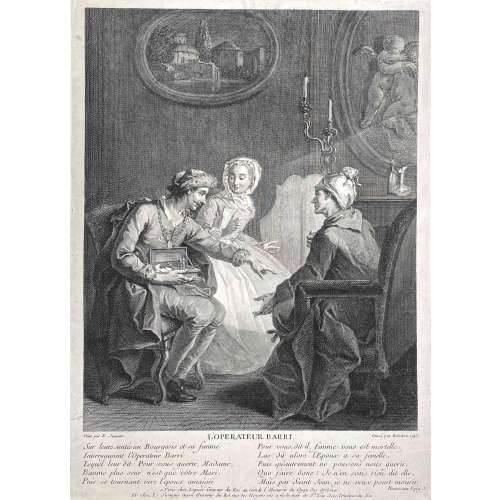
Engraving by J.J. Balechou after E. Jeaurat. A husband and wife ask a quack doctor for advice about health: he suggests substituting himself for the husband in the wife's affections, and she agrees: Épigrammes de Jean-Baptiste Rousseau (French, 1671–1741).
Date: 1743.
Size: 380 x 270 mm
Inscriptions under the image:
Top: Peint par E. Jeaurat | L'Operateur Barri | Grave par Balechou 1743
Middle: Sur leurs santés un Bourgeois et sa femme
Interrogeoient l'Operateur Barri, Lequel leur dit : Pour vous guérir, Madame, Baume plus sûr n'est que votre Mari, Puis se tournant vers l'époux amaigri, Pour vous, dit il, femme vous est mortelle, Las ! dit alors l'Epoux à sa femelle, Puis qu'autrement ne pouvons nous guérir, Que faire donc ? Je n'en sçai rien, dit elle,Mais, par Saint Jean, je ne veux point mourir.
Rousseau Epig. X
Center bottom: a Paris chez Lepicie Graveur du Roi au coin de l'Abreuvoir du Quay des Orfevres. Et Chez L. Surugue Aussi Graveur du Roi rue des Noyers vis a vis le mur de St. Yves Avec Privilege du Roi. -
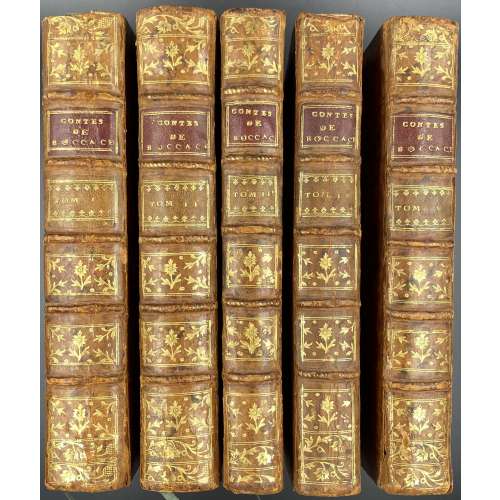 Five volumes, uniformly bound in marbled three-colour stained polished calf, spine with raised bands, gilt in compartments, crimson label with gilt lettering “CONTES DE BOCCACE”, cream label with volume number, marbled endpapers and all edges; bookplate pasted to first blank flyleaf “BIBLIOTHÈQUE DE LAJUDIE” depicting a coat of arms over an anchor, anchors and tulips scattered in the upper section, globe in the lower section, in a frame. Size: 21 x 14 cm. Translated by Antoine Le Maçon (French, 1500? – 1559). Vol. 1: [4] two blank leaves, portrait by Louis Lempereur after Hubert Gravelot, engraved t.p.: LE | DECAMERON | DE JEAN | BOCCACE. | TOME I. | Londres | 1757. | H. Gravelot Inv. […] T.P. N 21 […] J. Aliamet Sculp. ||, engraved frontispiece to Vie de Jean Bocace by Lempereur after Gravelot; Pagination: [i] ii-viii (Vie de Jean Bocace with head- and tail-pieces); [1] 2-320 [2] one blank leaf. Collation: 8vo; a4 A-V8, 164 leaves + 6 blanks + 24 plates (incl. portrait, frontis., and t.p.) extraneous to collation, 1 headpiece and 18 tailpieces. Vol. 2: [4] two blank leaves, engraved t.p.: LE | DECAMERON | DE JEAN | BOCCACE. | TOME II. | Londres 1757 | H. Gravelot inv. […] T.II. N.1. […] N. LeMire Sculp .||; Pagination: [1] 2-292 [2] one blank leaf. Collation: 8vo; A-S8 T2, 146 leaves + 3 blanks + 23 plates (incl. t.p.) extraneous to collation, and 18 tailpieces. Vol. 3: [4] two blank leaves, engraved t.p.: LE | DECAMERON | DE JEAN | BOCCACE. | TOME III. | Londres 1757 | Gravelot inv. […] T.III. N.1. […] Aillamet Sc. ||; Pagination: [1] 2-203 [204] [2] one blank leaf. Collation: 8vo; A-M8 N6, 102 leaves + 3 blanks + 23 plates (incl. t.p.) extraneous to collation, and 18 tailpieces. Vol. 4: [4] two blank leaves, engraved t.p.: LE | DECAMERON | DE JEAN | BOCCACE. | TOME IV. | Lond 1761 | Gravelot invenit […] T.IV. №.I. […] Alliamet Sculpsit. ||; Pagination: [1] 2-280 [2] one blank leaf. Collation: 8vo; A-R8 S4, 140 leaves + 3 blanks + 23 plates (incl. t.p.) extraneous to collation, and 20 tailpieces. Vol. 5: [4] two blank leaves, engraved t.p.: LE | DECAMERON | DE JEAN | BOCCACE. | TOME V. | Londres 1761 | Gravelot, inv. […] T.V. N.1. […] Aillamet Sc. ||; Pagination: [1] 2 [3] 4-269 [270] [2] one blank leaf. Collation: 8vo; A-Q8 R7, 135 leaves + 3 blanks + 23 plates (incl. t.p.) extraneous to collation, and 22 tailpieces. Total plates: 24+23+23+23+23=112; total vignettes: 19+ 18 + 18 +20 + 22 = 94; total etchings and engravings: 213. Ref: MFA ACCESSION NUMBER 37.1371a-e; Cohen-de Ricci 160; Ray, French Illustrated Book, 15 / p. 39-41; Metropolitan Museum, NY (Accession Number: 17.3.2641). Contributors: Authors: Giovanni Boccaccio (Italian, 1313–1375); Filippo Villani [Philippe-Matthieu Villani] (Italian, 1325 – 1407)Illustrated by: Hubert François Gravelot (French, 1699–1773). Artists: Charles Eisen (French, 1720–1778); François Boucher (French, 1703–1770); Charles-Nicolas Cochin le fils (French, 1715–1790), Jacques Aliamet (French, 1726–1788) Engravers: Jean Charles Baquoy (French, 1721–1777); Jean Jacques Flipart (French, 1719–1782); Louis Legrand (French, 1723–1807); Noël Le Mire (French, 1724–1801); Louis Simon Lempereur (French, 1725–1796); Catherine Elisabeth (Cousinet) Lempereur (French, born in 1726); Jean-Jacques André Le Veau (French, 1729–1786); Pierre Etienne Moitte (French, 1722–1780); Jean Ouvrier (French, 1725–1784); Jean Jacques Pasquier (French, died in 1785); Pierre (Pitre) Martenasie (Flemish, worked in France, died in 1770?); Augustin de Saint-Aubin (French, 1736–1807); Dominique Sornique (French, 1708 – 1756); Jacques Nicolas Tardieu (French, 1716–1791). Publisher: Prault (French, 18th century) Note: MFA copy has a slightly different collation: [v. 1] 152 leaves, plus plates; [v. 2] 136 ll., plus pls.; [v. 3] 98 ll., plus pls.; [v. 4] 131 ll., plus pls.; [v. 5] 124 ll., plus pls. This is their description: "First edition with these illustrations; a French translation (Cohen-de Ricci 160) appeared slightly later. Gravelot designed 89 of the 111 plates, and all 97 of the tailpieces, his largest single commission. Some 115 of his preliminary sketches by this series are in the Rosenwald Collection, Library of Congress; 131 of the final engraver's models are in the Widener Collection at the National Gallery of Art; and two other finished drawings are in the Ray Collection, Pierpont Morgan Library. Ten plates were designed by Eisen, and Cochin and Boucher had six each. As some plates in the later volumes are dated as late as 1761, the actual issuing of the volumes apparently extended to that date."
Five volumes, uniformly bound in marbled three-colour stained polished calf, spine with raised bands, gilt in compartments, crimson label with gilt lettering “CONTES DE BOCCACE”, cream label with volume number, marbled endpapers and all edges; bookplate pasted to first blank flyleaf “BIBLIOTHÈQUE DE LAJUDIE” depicting a coat of arms over an anchor, anchors and tulips scattered in the upper section, globe in the lower section, in a frame. Size: 21 x 14 cm. Translated by Antoine Le Maçon (French, 1500? – 1559). Vol. 1: [4] two blank leaves, portrait by Louis Lempereur after Hubert Gravelot, engraved t.p.: LE | DECAMERON | DE JEAN | BOCCACE. | TOME I. | Londres | 1757. | H. Gravelot Inv. […] T.P. N 21 […] J. Aliamet Sculp. ||, engraved frontispiece to Vie de Jean Bocace by Lempereur after Gravelot; Pagination: [i] ii-viii (Vie de Jean Bocace with head- and tail-pieces); [1] 2-320 [2] one blank leaf. Collation: 8vo; a4 A-V8, 164 leaves + 6 blanks + 24 plates (incl. portrait, frontis., and t.p.) extraneous to collation, 1 headpiece and 18 tailpieces. Vol. 2: [4] two blank leaves, engraved t.p.: LE | DECAMERON | DE JEAN | BOCCACE. | TOME II. | Londres 1757 | H. Gravelot inv. […] T.II. N.1. […] N. LeMire Sculp .||; Pagination: [1] 2-292 [2] one blank leaf. Collation: 8vo; A-S8 T2, 146 leaves + 3 blanks + 23 plates (incl. t.p.) extraneous to collation, and 18 tailpieces. Vol. 3: [4] two blank leaves, engraved t.p.: LE | DECAMERON | DE JEAN | BOCCACE. | TOME III. | Londres 1757 | Gravelot inv. […] T.III. N.1. […] Aillamet Sc. ||; Pagination: [1] 2-203 [204] [2] one blank leaf. Collation: 8vo; A-M8 N6, 102 leaves + 3 blanks + 23 plates (incl. t.p.) extraneous to collation, and 18 tailpieces. Vol. 4: [4] two blank leaves, engraved t.p.: LE | DECAMERON | DE JEAN | BOCCACE. | TOME IV. | Lond 1761 | Gravelot invenit […] T.IV. №.I. […] Alliamet Sculpsit. ||; Pagination: [1] 2-280 [2] one blank leaf. Collation: 8vo; A-R8 S4, 140 leaves + 3 blanks + 23 plates (incl. t.p.) extraneous to collation, and 20 tailpieces. Vol. 5: [4] two blank leaves, engraved t.p.: LE | DECAMERON | DE JEAN | BOCCACE. | TOME V. | Londres 1761 | Gravelot, inv. […] T.V. N.1. […] Aillamet Sc. ||; Pagination: [1] 2 [3] 4-269 [270] [2] one blank leaf. Collation: 8vo; A-Q8 R7, 135 leaves + 3 blanks + 23 plates (incl. t.p.) extraneous to collation, and 22 tailpieces. Total plates: 24+23+23+23+23=112; total vignettes: 19+ 18 + 18 +20 + 22 = 94; total etchings and engravings: 213. Ref: MFA ACCESSION NUMBER 37.1371a-e; Cohen-de Ricci 160; Ray, French Illustrated Book, 15 / p. 39-41; Metropolitan Museum, NY (Accession Number: 17.3.2641). Contributors: Authors: Giovanni Boccaccio (Italian, 1313–1375); Filippo Villani [Philippe-Matthieu Villani] (Italian, 1325 – 1407)Illustrated by: Hubert François Gravelot (French, 1699–1773). Artists: Charles Eisen (French, 1720–1778); François Boucher (French, 1703–1770); Charles-Nicolas Cochin le fils (French, 1715–1790), Jacques Aliamet (French, 1726–1788) Engravers: Jean Charles Baquoy (French, 1721–1777); Jean Jacques Flipart (French, 1719–1782); Louis Legrand (French, 1723–1807); Noël Le Mire (French, 1724–1801); Louis Simon Lempereur (French, 1725–1796); Catherine Elisabeth (Cousinet) Lempereur (French, born in 1726); Jean-Jacques André Le Veau (French, 1729–1786); Pierre Etienne Moitte (French, 1722–1780); Jean Ouvrier (French, 1725–1784); Jean Jacques Pasquier (French, died in 1785); Pierre (Pitre) Martenasie (Flemish, worked in France, died in 1770?); Augustin de Saint-Aubin (French, 1736–1807); Dominique Sornique (French, 1708 – 1756); Jacques Nicolas Tardieu (French, 1716–1791). Publisher: Prault (French, 18th century) Note: MFA copy has a slightly different collation: [v. 1] 152 leaves, plus plates; [v. 2] 136 ll., plus pls.; [v. 3] 98 ll., plus pls.; [v. 4] 131 ll., plus pls.; [v. 5] 124 ll., plus pls. This is their description: "First edition with these illustrations; a French translation (Cohen-de Ricci 160) appeared slightly later. Gravelot designed 89 of the 111 plates, and all 97 of the tailpieces, his largest single commission. Some 115 of his preliminary sketches by this series are in the Rosenwald Collection, Library of Congress; 131 of the final engraver's models are in the Widener Collection at the National Gallery of Art; and two other finished drawings are in the Ray Collection, Pierpont Morgan Library. Ten plates were designed by Eisen, and Cochin and Boucher had six each. As some plates in the later volumes are dated as late as 1761, the actual issuing of the volumes apparently extended to that date." -
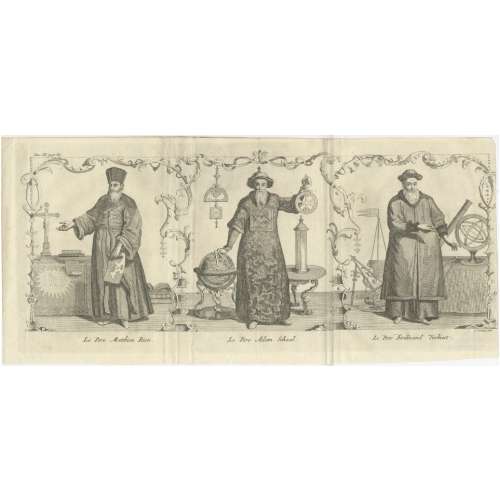
Three priests: Le Pere Matthieu Ricci, Le Pere Adam Schaal, and Le Pere Ferdinand Verbiest. Three priests with navigational instruments. Image taken from Description geographique, historique, chronologique et physique de l'Empire de la Chine et de la Tartarie Chinoise. Enrichies des cartes generales et particulieres de ces pays, etc. by Jean-Baptiste Du Halde (1674–1743), vol. 3, page 78. Originally published/produced in La Haye [The Hague], 1736. J.v.Solingen fecit
Jean-Baptiste Du Halde (Chinese: 杜赫德; 1 February 1674 – 18 August 1743) was a French Jesuit historian specializing in China. He did not travel to China, but collected seventeen Jesuit missionaries' reports and provided an encyclopedic survey of the history, culture and society of China and "Chinese Tartary," that is, Manchuria. Voltaire said of Du Halde's work: "Although it is developed out of Paris, and he hath not known the Chinese, [he] gave on the basis of the memoirs of his colleagues, the widest and the best description the empire of China has had worldwide." Le Pere Matthieu Ricci, a.k.a. Matteo Ricci, S.J. (Italian pronunciation: [matˈtɛːo ˈrittʃi]; Latin: Mattheus Riccius Maceratensis; 6 October 1552 – 11 May 1610), was an Italian Jesuit priest and one of the founding figures of the Jesuit China missions. His 1602 map of the world in Chinese characters introduced the findings of European exploration to East Asia. He is considered a Servant of God by the Roman Catholic Church. Ricci arrived at the Portuguese settlement of Macau in 1582 where he began his missionary work in China. He became the first European to enter the Forbidden City of Beijing in 1601 when invited by the Wanli Emperor, who sought his services in matters such as court astronomy and calendrical science. He converted several prominent Chinese officials to Catholicism, such as Xu Guangqi, who aided in translating Euclid's Elements into Chinese as well as the Confucian classics into Latin for the first time. Le Pere Adam Schaal, a.k.a. Johann Adam Schall von Bell (1 May 1591 – 15 August 1666) was a German Jesuit and astronomer. He spent most of his life as a missionary in China (where he is remembered as "Tang Ruowang") and became an adviser to the Shunzhi Emperor of the Qing dynasty. Le Pere Ferdinand Verbiest, a.k.a. Father Ferdinand Verbiest (9 October 1623 – 28 January 1688) was a Flemish Jesuit missionary in China during the Qing dynasty. He was born in Pittem near Tielt in the County of Flanders (now part of Belgium). He is known as Nan Huairen (南懷仁) in Chinese. He was an accomplished mathematician and astronomer and proved to the court of the Kangxi Emperor that European astronomy was more accurate than Chinese astronomy. He then corrected the Chinese calendar and was later asked to rebuild and re-equip the Beijing Ancient Observatory, being given the role of Head of the Mathematical Board and Director of the Observatory. He became close friends with the Kangxi Emperor, who frequently requested his teaching, in geometry, philosophy and music. Verbiest worked as a diplomat and cartographer, and also as a translator because he spoke Latin, German, Dutch, Spanish, Hebrew, and Italian. He wrote more than thirty books. During the 1670s, Verbiest designed what some claim to be the first ever self-propelled vehicle – many claims this as the world's first automobile, in spite of its small size and the lack of evidence that it was actually built.Joshua Van Solingen was an engraver and publisher from Holland, working, besides other places, in Scotland. Information about him can be found at Catastrophic Bliss (The Griot Project Book Series) by Accounting in Scotland (RLE Accounting): A Historical Bibliography History of the Scottish Metrical Psalms: With an Account of the Paraphrases ... The History of Edinburgh, from the Earliest Accounts to the Present Time ... History of the Bassandyne Bible, the First Printed in Scotland: With Notices ...
-
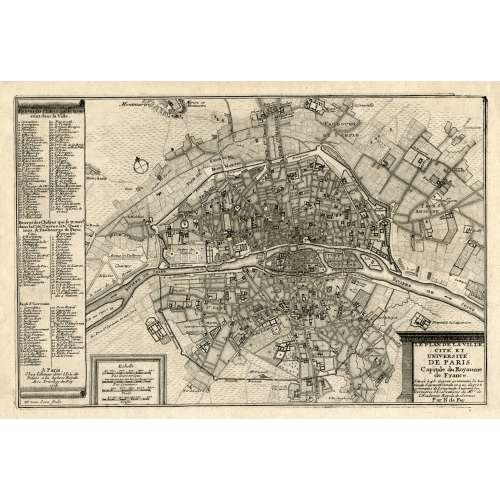 LE PLAN DE LA VILLE, | CITE, ET | UNIVERSITÉ | DE PARIS. | Capitale du Royaume | de France. | {5 lines in italic} | Par N. de Fer. | A Paris, | Chez l’Auteur dans l’Isle du | Palais a la Sphere Royale. | Avec Privilege du Roy. | 1705 | H. van Loon sculp. || Dimensions: Sheet: 27 x 39 cm; Image: 22 x 33 cm. Contributors: Nicolas de Fer (French, 1646 – 1720) – cartographer. Harmanus van Loon (Flemish, fl. c. 1690 – c. 1725) – engraver.
LE PLAN DE LA VILLE, | CITE, ET | UNIVERSITÉ | DE PARIS. | Capitale du Royaume | de France. | {5 lines in italic} | Par N. de Fer. | A Paris, | Chez l’Auteur dans l’Isle du | Palais a la Sphere Royale. | Avec Privilege du Roy. | 1705 | H. van Loon sculp. || Dimensions: Sheet: 27 x 39 cm; Image: 22 x 33 cm. Contributors: Nicolas de Fer (French, 1646 – 1720) – cartographer. Harmanus van Loon (Flemish, fl. c. 1690 – c. 1725) – engraver. -
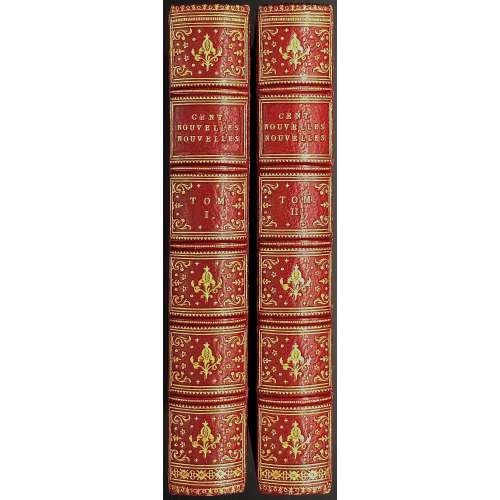 Description: Two volumes, 16.5 x 11 cm, collated 8vo, uniformly bound in the mid-19th century by H. Stamper (stamp to verso free endpaper) in red Morocco, ornated with gilt fillets and dentelles to boards and turn-ins, spine with raised bands and gilt decorations and lettering in compartments, marbled endpapers, all edges gilt; printed on laid paper; bookplate to front pastedown “EX LIBRIS | DANIEL | BERDITCHEVSKY”. Title-page (red and black, tall ‘s’): LES CENT | NOUVELLES | NOUVELLES. | SUIVENT LES CENT NOUVELLES | CONTENANT | Les Cent Histoires Nouveaux, | Qui sont moult plaisans a raconter, | En toutes bonnes Compagnies, | Par MANIERE DE JOYEUSETÉ. | Avec d'excellentes Figures en Taille-douce, | Gravées sur les desseins du fameux Mr. | ROMAIN DE HOOGE | & retouchées par feu | B. PICART LE ROMAIN | TOME PREMIER (TOME SECOND) |{device} | A COLOGNE | Chez Pierre Gaillard. | M.DCCXXXVI. || Vol. 1: Collation: [1] flyleaf torn out, [1] frontispiece, [1] title-page, [3] preface (*2-4), [1] Auertissement, [10] table (2+**-**8), A-Bb8 (Bb8 blank); 45 in-text half-page copperplate etchings by various engravers after Romain de Hooge; total 215 leaves plus ffl and frontispiece by Gilliam van der Gouwen after Romain de Hooge. Pagination (starting from t.p.): [30] 1-397 [398] [2], total 430 pages. Vol. 2: Collation: ffl, [*1] t.p., [11] table (*2-8, **-4), A-Aa8 Bb4 (Bb4 blank); 55 in-text half-page copperplate etchings by various engravers after Romain de Hooge; total 208 leaves plus ffl. Pagination: [24] 1-389 [390] [2], total 416 pages. Catalogue raisonné: Landwehr (1970) № 94, p. 203; Lewine (1898) p. 326; Cohen-DeRicci (1912) p. 658. Landwehr cites two editions after the 1st of 1701: Amsterdam 1732 and Cologne 1786 [i.e. 1736]. Both Lewine and Cohen-DeRicci attribute the text to Louis XI and mention the 1736 reprint (though not 1786). The first edition of “Les cent nouvelles nouvelles” appeared in 1486 by commission of Duke of Burgundy Philippe le Bon; the text is attributed to Philippe Pot (1428 – 1493), Antoine de La Sale (c. 1385 – c. 1460) or King Louis XI (1423 – 1483). Contributors: Artists: Romain de Hooge (Dutch, 1645 – 1708) Bernard Picart (French, 1673 – 1733) Engravers: Gilliam van der Gouwen (Dutch, c. 1657 – 1716) (frontispiece) Laurens Scherm (Dutch, fl. 1689 – 1701) (nouvelles XXIX, XXX, LXXVII) Jan Van Vianen (Dutch, c.1660 – 1726?) (nouvelles L, LII, LVII-LX, LXIV-LXVII, LXX) Binder: Henry Stamper (British, 1802? – 1887) Commissioner: Philippe le Bon [Philip III] (French, 1396 – 1467) Publisher: Pierre Gaillard (French, fl. 1715 – 1737)
Description: Two volumes, 16.5 x 11 cm, collated 8vo, uniformly bound in the mid-19th century by H. Stamper (stamp to verso free endpaper) in red Morocco, ornated with gilt fillets and dentelles to boards and turn-ins, spine with raised bands and gilt decorations and lettering in compartments, marbled endpapers, all edges gilt; printed on laid paper; bookplate to front pastedown “EX LIBRIS | DANIEL | BERDITCHEVSKY”. Title-page (red and black, tall ‘s’): LES CENT | NOUVELLES | NOUVELLES. | SUIVENT LES CENT NOUVELLES | CONTENANT | Les Cent Histoires Nouveaux, | Qui sont moult plaisans a raconter, | En toutes bonnes Compagnies, | Par MANIERE DE JOYEUSETÉ. | Avec d'excellentes Figures en Taille-douce, | Gravées sur les desseins du fameux Mr. | ROMAIN DE HOOGE | & retouchées par feu | B. PICART LE ROMAIN | TOME PREMIER (TOME SECOND) |{device} | A COLOGNE | Chez Pierre Gaillard. | M.DCCXXXVI. || Vol. 1: Collation: [1] flyleaf torn out, [1] frontispiece, [1] title-page, [3] preface (*2-4), [1] Auertissement, [10] table (2+**-**8), A-Bb8 (Bb8 blank); 45 in-text half-page copperplate etchings by various engravers after Romain de Hooge; total 215 leaves plus ffl and frontispiece by Gilliam van der Gouwen after Romain de Hooge. Pagination (starting from t.p.): [30] 1-397 [398] [2], total 430 pages. Vol. 2: Collation: ffl, [*1] t.p., [11] table (*2-8, **-4), A-Aa8 Bb4 (Bb4 blank); 55 in-text half-page copperplate etchings by various engravers after Romain de Hooge; total 208 leaves plus ffl. Pagination: [24] 1-389 [390] [2], total 416 pages. Catalogue raisonné: Landwehr (1970) № 94, p. 203; Lewine (1898) p. 326; Cohen-DeRicci (1912) p. 658. Landwehr cites two editions after the 1st of 1701: Amsterdam 1732 and Cologne 1786 [i.e. 1736]. Both Lewine and Cohen-DeRicci attribute the text to Louis XI and mention the 1736 reprint (though not 1786). The first edition of “Les cent nouvelles nouvelles” appeared in 1486 by commission of Duke of Burgundy Philippe le Bon; the text is attributed to Philippe Pot (1428 – 1493), Antoine de La Sale (c. 1385 – c. 1460) or King Louis XI (1423 – 1483). Contributors: Artists: Romain de Hooge (Dutch, 1645 – 1708) Bernard Picart (French, 1673 – 1733) Engravers: Gilliam van der Gouwen (Dutch, c. 1657 – 1716) (frontispiece) Laurens Scherm (Dutch, fl. 1689 – 1701) (nouvelles XXIX, XXX, LXXVII) Jan Van Vianen (Dutch, c.1660 – 1726?) (nouvelles L, LII, LVII-LX, LXIV-LXVII, LXX) Binder: Henry Stamper (British, 1802? – 1887) Commissioner: Philippe le Bon [Philip III] (French, 1396 – 1467) Publisher: Pierre Gaillard (French, fl. 1715 – 1737) -
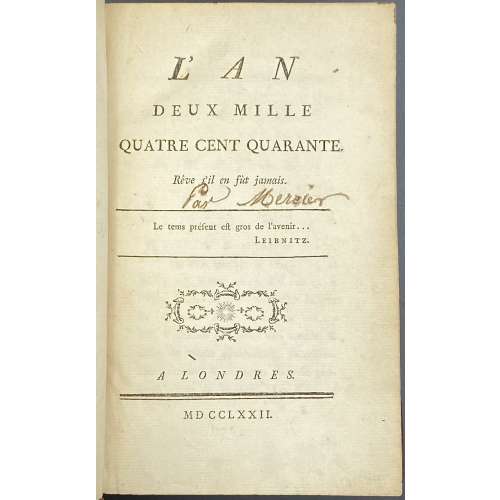 Title page: L'AN DEUX MILLE QUATRE CENT QUARANTE. | Rêve s'il en fût jamais. | Le temps présent est gros de l'avenir... | Leibnitz. | {letterpress device} | A LONDRES. | MD CCLXXII. || Pagination: [i-iv] v-xii, 1-402 [2]; Collation: 8vo; π6 A-Z8 Aa-Bb8 Cc2. Binding: 19 x 12 cm, full mottled calf, rebacked, spine with gilt-lettered red label, compartments ruled gilt, with gilt fleuron ornament, marbled endpapers and all edges; printed on laid paper, with tall “s”. Probably published in Paris, anonymously. Handwritten nut-ink inscription to the title "Par Mercier". See also: LIB-0979.2016
Title page: L'AN DEUX MILLE QUATRE CENT QUARANTE. | Rêve s'il en fût jamais. | Le temps présent est gros de l'avenir... | Leibnitz. | {letterpress device} | A LONDRES. | MD CCLXXII. || Pagination: [i-iv] v-xii, 1-402 [2]; Collation: 8vo; π6 A-Z8 Aa-Bb8 Cc2. Binding: 19 x 12 cm, full mottled calf, rebacked, spine with gilt-lettered red label, compartments ruled gilt, with gilt fleuron ornament, marbled endpapers and all edges; printed on laid paper, with tall “s”. Probably published in Paris, anonymously. Handwritten nut-ink inscription to the title "Par Mercier". See also: LIB-0979.2016 -
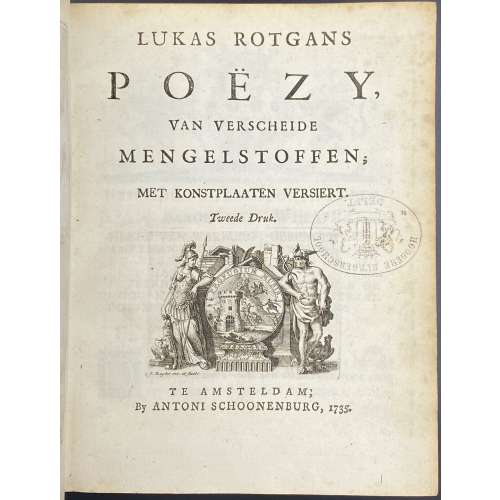 Title-page: LUKAS ROTGANS | POËZY, | VAN VERSCHEIDE | MENGELSTOFFEN; | MET KONSTPLAATEN VERSIERT. | Tweede Druk | {vignette} | TE AMSTERDAM; | By ANTONI SCHOONENBURG, 1735. || Collation: 4to; fep, 1st blank, engraved t.p. by M. Pool, t.p., *3,4; 2*-9*4, 10*1, *LII2, *LII, 10*2 —> *-10*4 (40 leaves); A-Z4, 2A-2Z4, 3A-3Z4, 4A-4Q4, last blank, fep; (340 leaves), 2 plates extraneous to collation. Pagination: [2] [1-5] 6-14 [15-80] [1-3] 4-680 [2], 2 unsigned plates not included in pagination after pp. 634 and 652, 50 headpieces by Jacob Folkema after Arnold Houbraken, and 2 tailpieces by Jan de Ruijter. Marks: Armorial bookplate: “Ex Libris J. J. Mak | {coat of arms} | Inveni Intermanere Melius”. Oval ink stamp: “HOOGERE BURGERSCHOOL. | DELFT” Provenance: Johannes Jacobus Mak (Dutch, 1908 – 1975). Edition: 2nd, 1st edition published in 1715 in Leeuwarden by François Halma. Contributors: Lukas Rotgans (Dutch, 1653 – 1710) – author. Arnold Houbraken (Dutch, 1660 – 1719) – artist. Jacob Folkema (Dutch, 1692 – 1767) – engraver. Matthijs Pool (Dutch, 1676 – 1740) – engraver. Jan de Ruijter (Dutch, 1688 – 1744) – engraver. Antoni Schoonenburg (Dutch, 1682 – 1754) – publisher.
Title-page: LUKAS ROTGANS | POËZY, | VAN VERSCHEIDE | MENGELSTOFFEN; | MET KONSTPLAATEN VERSIERT. | Tweede Druk | {vignette} | TE AMSTERDAM; | By ANTONI SCHOONENBURG, 1735. || Collation: 4to; fep, 1st blank, engraved t.p. by M. Pool, t.p., *3,4; 2*-9*4, 10*1, *LII2, *LII, 10*2 —> *-10*4 (40 leaves); A-Z4, 2A-2Z4, 3A-3Z4, 4A-4Q4, last blank, fep; (340 leaves), 2 plates extraneous to collation. Pagination: [2] [1-5] 6-14 [15-80] [1-3] 4-680 [2], 2 unsigned plates not included in pagination after pp. 634 and 652, 50 headpieces by Jacob Folkema after Arnold Houbraken, and 2 tailpieces by Jan de Ruijter. Marks: Armorial bookplate: “Ex Libris J. J. Mak | {coat of arms} | Inveni Intermanere Melius”. Oval ink stamp: “HOOGERE BURGERSCHOOL. | DELFT” Provenance: Johannes Jacobus Mak (Dutch, 1908 – 1975). Edition: 2nd, 1st edition published in 1715 in Leeuwarden by François Halma. Contributors: Lukas Rotgans (Dutch, 1653 – 1710) – author. Arnold Houbraken (Dutch, 1660 – 1719) – artist. Jacob Folkema (Dutch, 1692 – 1767) – engraver. Matthijs Pool (Dutch, 1676 – 1740) – engraver. Jan de Ruijter (Dutch, 1688 – 1744) – engraver. Antoni Schoonenburg (Dutch, 1682 – 1754) – publisher. -
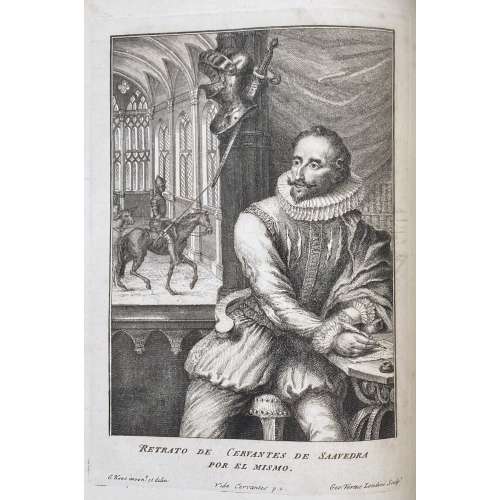 Two volumes uniformly bound by Riviere & Son in full red marbled calf, triple fillet border stamped in gilt, elaborate gilt ornament and brown morocco labels with gilt lettering to spine, all edge gilt, gilt dentelles. Vol. 1: Title page: THE | LIFE AND EXPLOITS | Of the ingenious gentleman | DON QUIXOTE | DE LA MANCHA. | Translated from the Original Spanish of | Miguel Cervantes de Saavedra. | By CHARLES JARVIS, Esq; | IN TWO VOLUMES. | {single rule} | VOLUME the FIRST. | {double rule} | LONDON: | Printed for J. and R. Tonson in the Strand, and | R. Dodsley in Pall-Mall. | {single rule} | M DCC XLII || Pagination: [i-iii] iv-xxxii, [i-iii] iv-vi, [2], [1] 2-90, [14], [1] 2-355 [356]; 500 pages total + ils. Collation: 4to; 250 leaves; A4 a-b4 c-d2, A4, a-l4 m2 n4 o2, B-Z4, Aa-Yy4 Z2, ils. Illustrations: 27 full-page copperplate engravings, incl. frontispiece (skillfully repaired), portrait of Cervantes by George Vertue After G. Kent and a fictional portrait of Don Quixote by George Vertue after John Vanderbank. Vol. 2: Title page: THE | LIFE AND EXPLOITS | Of the ingenious gentleman | DON QUIXOTE | DE LA MANCHA. | Translated from the Original Spanish of | Miguel Cervantes de Saavedra. | By CHARLES JARVIS, Esq; | {single rule} | VOLUME the SECOND. | {double rule} | LONDON: | Printed for J. and R. Tonson in the Strand, and | R. Dodsley in Pall-Mall. | {single rule} | M DCC XLII || Pagination: [i-iii] iv-xii, [1] 2-388; 400 pages total + ils. Collation: 4to; 200 leaves; A4 a2 B-Z4 Aa-Zz4 Aaa-Ccc4 Ddd2, ils. Illustrations:41 full-page copperplate engravings, pl. 29 (as frontispieces) precedes pl. 28. Contributors: Author: Miguel de Cervantes Saavedra (Spanish, 1547 – 1616) Translator: Charles Jervas (British, 1675 – 1739) Author: Cervantes biography by Gregorio Mayans y Siscar (Spanish, 1699 – 1781) Translator: Cervantes biography by John Ozell (British, d. 1743) Illustrator: John Vanderbank, the younger (British, 1694 – 1739) Artist: (Cervantes portrait): G. Kent (British, fl. 1738 – 1742) Engravers: Gerard Vandergucht (British, 1696 – 1776); George Vertue (British, 1684 – 1756); Bernard Baron (French, 1696 – 1762); Claude Du Bosc (French, 1682 – 1746 or later) Publishers: J. and R. Tonson (London); Robert Dodsley (British, 1703 – 1764) Catalogue raisonné: Lewine p. 102 Reference: Metropolitan Museum (New York)
Two volumes uniformly bound by Riviere & Son in full red marbled calf, triple fillet border stamped in gilt, elaborate gilt ornament and brown morocco labels with gilt lettering to spine, all edge gilt, gilt dentelles. Vol. 1: Title page: THE | LIFE AND EXPLOITS | Of the ingenious gentleman | DON QUIXOTE | DE LA MANCHA. | Translated from the Original Spanish of | Miguel Cervantes de Saavedra. | By CHARLES JARVIS, Esq; | IN TWO VOLUMES. | {single rule} | VOLUME the FIRST. | {double rule} | LONDON: | Printed for J. and R. Tonson in the Strand, and | R. Dodsley in Pall-Mall. | {single rule} | M DCC XLII || Pagination: [i-iii] iv-xxxii, [i-iii] iv-vi, [2], [1] 2-90, [14], [1] 2-355 [356]; 500 pages total + ils. Collation: 4to; 250 leaves; A4 a-b4 c-d2, A4, a-l4 m2 n4 o2, B-Z4, Aa-Yy4 Z2, ils. Illustrations: 27 full-page copperplate engravings, incl. frontispiece (skillfully repaired), portrait of Cervantes by George Vertue After G. Kent and a fictional portrait of Don Quixote by George Vertue after John Vanderbank. Vol. 2: Title page: THE | LIFE AND EXPLOITS | Of the ingenious gentleman | DON QUIXOTE | DE LA MANCHA. | Translated from the Original Spanish of | Miguel Cervantes de Saavedra. | By CHARLES JARVIS, Esq; | {single rule} | VOLUME the SECOND. | {double rule} | LONDON: | Printed for J. and R. Tonson in the Strand, and | R. Dodsley in Pall-Mall. | {single rule} | M DCC XLII || Pagination: [i-iii] iv-xii, [1] 2-388; 400 pages total + ils. Collation: 4to; 200 leaves; A4 a2 B-Z4 Aa-Zz4 Aaa-Ccc4 Ddd2, ils. Illustrations:41 full-page copperplate engravings, pl. 29 (as frontispieces) precedes pl. 28. Contributors: Author: Miguel de Cervantes Saavedra (Spanish, 1547 – 1616) Translator: Charles Jervas (British, 1675 – 1739) Author: Cervantes biography by Gregorio Mayans y Siscar (Spanish, 1699 – 1781) Translator: Cervantes biography by John Ozell (British, d. 1743) Illustrator: John Vanderbank, the younger (British, 1694 – 1739) Artist: (Cervantes portrait): G. Kent (British, fl. 1738 – 1742) Engravers: Gerard Vandergucht (British, 1696 – 1776); George Vertue (British, 1684 – 1756); Bernard Baron (French, 1696 – 1762); Claude Du Bosc (French, 1682 – 1746 or later) Publishers: J. and R. Tonson (London); Robert Dodsley (British, 1703 – 1764) Catalogue raisonné: Lewine p. 102 Reference: Metropolitan Museum (New York) -
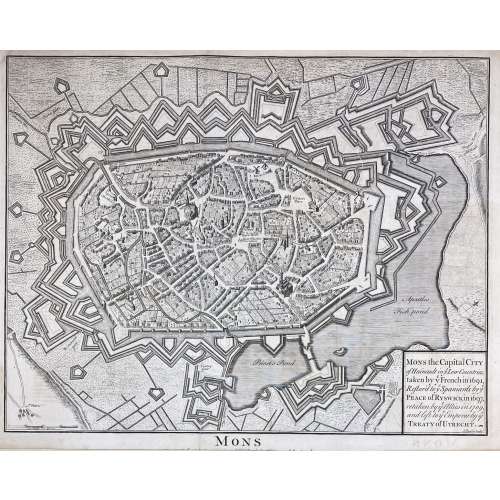
Mons the Capital City of Hainault in y Low Countries, taken by y French in 1691, Restor'd to y Spaniards by y Peace of Ryswick in 1697, retaken by y Allies in 1709, and left to y Emperor by y Treaty of Utrecht. attribution to publication source has been trimmed.
Dimensions: Sheet: 40.7 x 52.5 cm; Image: 37.5 x 48 cm. Published between 1744 and 1747. Attribution to publication source has been trimmed. Reference: Royal Academy 03/2919. Source: Maps for Mr. Tindal's Continuation of Mr. Rapin's History of England. London: John and Paul Knapton. Nicolas Tindal (British, 1687 – 1774) – the translator and continuer of the History of England by Paul de Rapin. Paul de Rapin (French, 1661 – 1725) – a Huguenot historian, author of the History of England. -

Copper tsuba of slightly elongated round form carved in low relief (shishiaibori and sukisagebori) and inlaid in gold, silver and shakudō with the design of dreaming Rosei (Lu Sheng): he is half-sitting by the pillow with his eyes closed, holding his fan, with a scroll by his feet, surrounded by flying butterflies.
Edo period, first half of the 18th century.
Dimensions: 70.8 x 67.1 x 5.0 mm. Signed on the reverse: Jōi (乗 意) + Kaō. Sugiura Jōi [杉 浦 乗 意] (1701-1761) was a master of Nara School in Edo; he was a student of Toshinaga [M. Sesko, ‘Genealogies’, p. 32]. “Sugiura Jōi (1701-1761) made many fuchigashira and kozuka, tsuba are rather rare.” [M. Sesko, The Japanese toso-kinko Schools, pp. 148-149]. On Rosei (Lu Sheng) dream's legend see Legend in Japanese Art by Henri L. Joly (1908 edition) on page 293. -
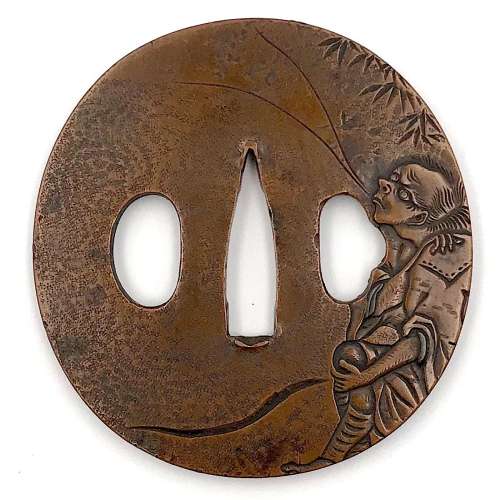
Copper tsuba of oval form carved in kebori and katakiribori with Tekkai Sennin sitting under bamboo on the face and with a pine tree on the back. Ishime-ji treated surface.
Signed on the reverse: Jōi (乗 意).
Edo period (First half of 18th century). Dimensions: 69.6 x 66.5 x 4.5 mm Sugiura Jōi (杉 浦 乗 意) was a master of Nara School in Edo; he was a student of Toshinaga [M. Sesko, 'Genealogies', p. 32]. "Sugiura Jōi (1701-1761) made many fuchigashira and kozuka, tsuba are rather rare." [M. Sesko, The Japanese toso-kinko Schools]. -
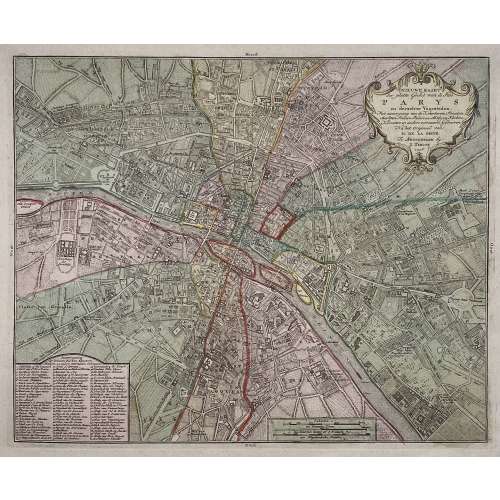
Title: NIEUWE KAART | der platte Grond van de Stad | PARYS | en derzelver Voorsteden. | Met aanwyzing van de Kwartieren, Staaten, | Markten, Pleinen, Paleizen, Abtyden, Kerken, | Kloosters en andere voornaame Gebouwen. | Na het Origineel van | M. DE LA GRIVE. | Te Amsterdam by | I. Tirion. | 1756. ||
Author : Jean Delagrive (French, 1689-1757)
Publisher: Isaak Tirion (Dutch, 1705 – 1765)
Publication date: 1756.
Dimensions: Sheet: 42.5 x 53.8 cm; Image: 30.7 x 37.7 cm.
Plate № 59 from Beknopte Atlas van omtrent honderd platte gronden der voornaamste vestingen, kasteelen en Steden van Europa. -
 Iron tsuba of oval form with design of stylized paulownia (nage-giri) in openwork (sukashi). Leaf veins carved in kebori technique. Rounded rim. Copper sekigane. Unsigned. Attributed to Kanshirō, third generation Nishigaki (1680-1761). Edo period: Early 18th century (Kyoho / Genbun era). Size: Height: 77.8 mm. Width: 71.9 mm. Rim thickness: 5.9 mm. Center thickness: 5.0 mm. Provenance: Sasano Masayuki Collection, № 264: "Nishigaki. Third generation Kanshiro (died in in the eleventh year of Hohreki, 1761 at the age of eighty-two). This oblong shape appears a little amateurish at first, however, it was done intentionally to add flavor to to the design. The neat composition is a feature of the third Kanshiro."
Iron tsuba of oval form with design of stylized paulownia (nage-giri) in openwork (sukashi). Leaf veins carved in kebori technique. Rounded rim. Copper sekigane. Unsigned. Attributed to Kanshirō, third generation Nishigaki (1680-1761). Edo period: Early 18th century (Kyoho / Genbun era). Size: Height: 77.8 mm. Width: 71.9 mm. Rim thickness: 5.9 mm. Center thickness: 5.0 mm. Provenance: Sasano Masayuki Collection, № 264: "Nishigaki. Third generation Kanshiro (died in in the eleventh year of Hohreki, 1761 at the age of eighty-two). This oblong shape appears a little amateurish at first, however, it was done intentionally to add flavor to to the design. The neat composition is a feature of the third Kanshiro." -
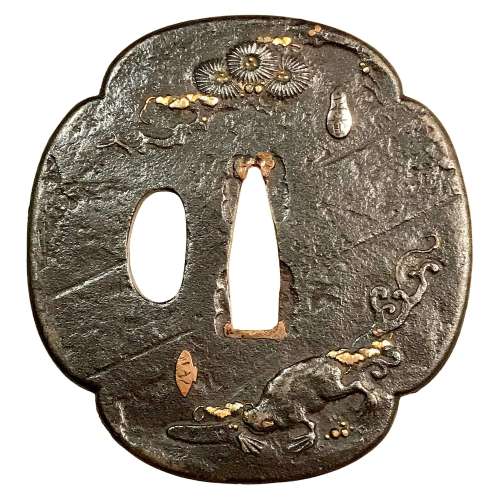
Iron tsuba of mokkō-form with a pine and a frog on the face and a snail on the back, carved and inlaid with gold. Each figurative element of the design is signed on three inlaid cartouches: Masaharu (正春), Kazuyuki (一之), and Yoshikazu (良一) [read by Markus Sesko]. Snake, snail, and frog together make a design called "SANSUKUMI" - Three Cringing Ones [Merrily Baird]. The snail can poison the snake, the frog eats the snail, and the snake eats the frog. It's unclear whether the pine replaces the snake on this tsuba, or the snake is hiding in the pine? Anyway, the frog and the snail are clearly represented. "Maybe we have here a joint work with Masaharu (the silver cartouche next to the pine) being the master and making the plate and Kazuyuki and Yoshikazu as his students carving out the frog and the snail respectively". Copper sekigane.
Dimensions: 70.9 x 67.2 x 3.0 mm. Edo period (18th century).Markus Sesko writes: "I agree, the frog and the snail most likely allude to the san-sukumi motif. It is possible that we have here an artist's choice to deliberately leave out the snake, maybe he thought that the motif is already obvious and there is no need to add a snake to make it clear that the tsuba shows the san-sukumi motif." [Markus Sesko].
Kazuyuki (一之): adopted son of Kumagai Yoshiyuki, student of Ichijō (Gotō-Ichijō Scool) [M. Sesko 'Genealogies', page 19.] Masaharu (正春): Kasuya fam., student of Masamichi (1707-1757) who was the 4th generation Nomura School master in Edo. [M. Sesko 'Genealogies', page 49.] -
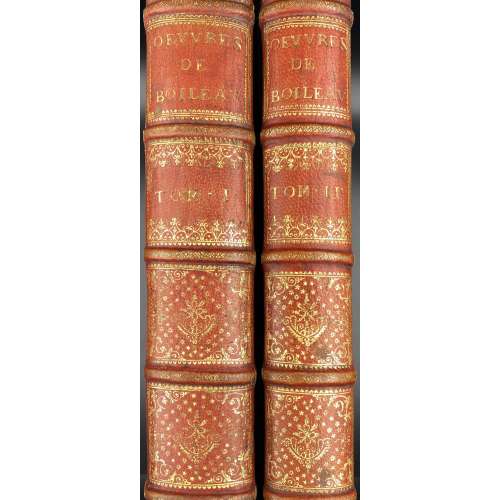 Description: two volumes, 38.3 x 25.5 cm each, uniformly bound in red morocco, boards decorated in gilt in the style of Luc-Antoine Boyet, with gilt dentelle inside out; spine with raised bands, gilt lettering, gilt in compartments; all edges gilt; marbled endpapers; printed on laid paper, text in the floral frame, engraved frontispiece (after Hyacinthe Rigaud), plates, t.p. vignette with the portrait of Desiderius Erasmus (after Quentin Metsys), head- and tailpieces (total of 40, some repeating) and 2 initials by Bernard Picart, folded portrait of dedicatee Guillelmine Charlotte Princesse de Galles &c &c &c by van Gunst after Kneller. Title-page (red and black, tall ‘s’): OEUVRES | DE | NICOLAS BOILEAU | DESPRÉAUX. | AVEC DES | ÉCLAIRCISSEMENTS | HISTORIQUES, | DONNEZ PAR LUI-MEME. | Nouvelle Edition revuë, corrigée & augmentée de diverses Remarques. | Enrichie de figures gravées par Bernard Picart le Romain. | TOME PREMIER (SECOND). | {vignette} | A AMSTERDAM, | Chez DAVID MORTIER. | — | M DCCXVIII. | AVEC PRIVILEGE. || Vol. 1. Collation: 4to; 1 ffl, a-c4 d1 A-3K4, 3L2, 1ffl; (K3 marked I3). Plates: t.p. vignette, frontispiece, 24 head- and tailpieces, f.t. in a grotesque frame and 6 full-page for ‘Le Lutrin’ in the same frame by Bernard Picart; folded portrait of Guillelmine Charlotte, Princess of Wales by van Gunst after Kneller. Pagination: [4] [i-v] vi-xviii [4] [1] 2-450 [2]. Vol. 2. Collation: 4to; 2 ffl, π2 A-3C4 3D3 2 ffl; (V3 marked T3, 2L4 marked A). Plates: t.p. vignette (same as vol.1) and 7 head- and tailpieces by Bernard Picart. Pagination: [4] [i-iii] iv-vii [viii] [1] 2-370 [2] [20]. Catalogue raisonné: Lewine 72-3; Cohen-De Ricci 165-6. Contributors: Luc-Antoine Boyet (French, fl. 1684 – 1733) – bookbinder. Claude Brossette (French, 1671 – 1743) – author, remarks. André Dacier (French, 1651 – 1722) – author, preface. Nicolas Boileau Despréaux (French, 1636 – 1711) – author. Pieter Stevens van Gunst (Dutch, 1659-1724) – engraver. Sir Godfrey Kneller (British, 1646-1723) – artist. David Mortier (Dutch-British, 1673 – 1728) – publisher. Bernard Picard (French, 1673 – 1733) – artist, engraver. Quentin Massijs [Metsys, Matsys] (Flemish, 1466 – 1530) – artist. Hyacinthe Rigaud [Jacint Rigau-Ros i Serra] (French, 1659 - 1743) – artist. Guillelmine Charlotte, Princess of Wales (Wilhelmina Charlotte Caroline of Brandenburg-Ansbach) (1683 – 1737) – dedicatee
Description: two volumes, 38.3 x 25.5 cm each, uniformly bound in red morocco, boards decorated in gilt in the style of Luc-Antoine Boyet, with gilt dentelle inside out; spine with raised bands, gilt lettering, gilt in compartments; all edges gilt; marbled endpapers; printed on laid paper, text in the floral frame, engraved frontispiece (after Hyacinthe Rigaud), plates, t.p. vignette with the portrait of Desiderius Erasmus (after Quentin Metsys), head- and tailpieces (total of 40, some repeating) and 2 initials by Bernard Picart, folded portrait of dedicatee Guillelmine Charlotte Princesse de Galles &c &c &c by van Gunst after Kneller. Title-page (red and black, tall ‘s’): OEUVRES | DE | NICOLAS BOILEAU | DESPRÉAUX. | AVEC DES | ÉCLAIRCISSEMENTS | HISTORIQUES, | DONNEZ PAR LUI-MEME. | Nouvelle Edition revuë, corrigée & augmentée de diverses Remarques. | Enrichie de figures gravées par Bernard Picart le Romain. | TOME PREMIER (SECOND). | {vignette} | A AMSTERDAM, | Chez DAVID MORTIER. | — | M DCCXVIII. | AVEC PRIVILEGE. || Vol. 1. Collation: 4to; 1 ffl, a-c4 d1 A-3K4, 3L2, 1ffl; (K3 marked I3). Plates: t.p. vignette, frontispiece, 24 head- and tailpieces, f.t. in a grotesque frame and 6 full-page for ‘Le Lutrin’ in the same frame by Bernard Picart; folded portrait of Guillelmine Charlotte, Princess of Wales by van Gunst after Kneller. Pagination: [4] [i-v] vi-xviii [4] [1] 2-450 [2]. Vol. 2. Collation: 4to; 2 ffl, π2 A-3C4 3D3 2 ffl; (V3 marked T3, 2L4 marked A). Plates: t.p. vignette (same as vol.1) and 7 head- and tailpieces by Bernard Picart. Pagination: [4] [i-iii] iv-vii [viii] [1] 2-370 [2] [20]. Catalogue raisonné: Lewine 72-3; Cohen-De Ricci 165-6. Contributors: Luc-Antoine Boyet (French, fl. 1684 – 1733) – bookbinder. Claude Brossette (French, 1671 – 1743) – author, remarks. André Dacier (French, 1651 – 1722) – author, preface. Nicolas Boileau Despréaux (French, 1636 – 1711) – author. Pieter Stevens van Gunst (Dutch, 1659-1724) – engraver. Sir Godfrey Kneller (British, 1646-1723) – artist. David Mortier (Dutch-British, 1673 – 1728) – publisher. Bernard Picard (French, 1673 – 1733) – artist, engraver. Quentin Massijs [Metsys, Matsys] (Flemish, 1466 – 1530) – artist. Hyacinthe Rigaud [Jacint Rigau-Ros i Serra] (French, 1659 - 1743) – artist. Guillelmine Charlotte, Princess of Wales (Wilhelmina Charlotte Caroline of Brandenburg-Ansbach) (1683 – 1737) – dedicatee -
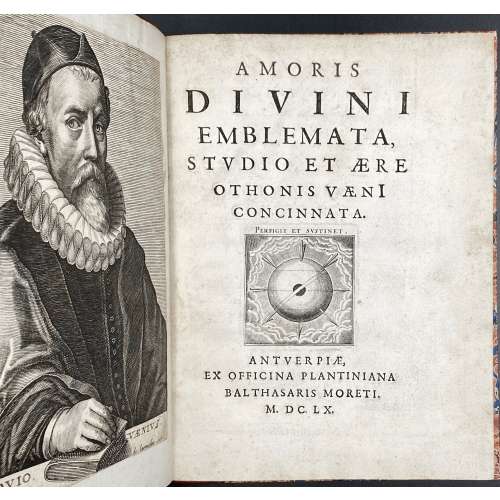 Amoris Divini Emblemata, Studio Et Aere Othonis Vaeni Concinata. — Antverpiae: Ex Officina Plantiniana Balthasaris Moreti, MDCLX [1660]. — pp.: [1] (Van Veen port.), [1] title, [2] (Isabella port.), 3-127 [1], 60 illustr. — 2nd impression. Octavius Vaenius, a.k.a. Otto Vaenius or Otto Van Veen (c. 1556-1629) was Rubens's last and most influential teacher. The Amoris divini emblemata was first published in 1615 by Nutius & Meursius in Antwerp. Vaenius’s book was to influence Herman Hugo's Pia desideria (LIB-1657.2018). Book structure: On frontispiece, trimmed and mounted portrait of Octavius Vaenius painted by his daughter Gertruida van Veen (signed Gertrudis filia) and engraved by Nicolas de Larmessin. Trimmed portrait of the Infanta Isabella Clara of Austria (1566 – 1633) pained by Peter Paul Rubens and engraved by Jan de Leeuw mounted to title verso. 60 engraved plates with emblems are on recto pages with facing texts: Latin quotations from Bible and Fathers, Spanish verses by Alphonso de Ledesma, Dutch by Vaenius and French by Carolus Philippus Hattron (d. 1632). Rebound in the mid-19th century in brown quarter Morocco with blind marbled boards and gilt lettering to spine. Inscription in ink on verso to van Veen portrait: "I bought this volume with the portraits inserted at the sale of the library of my uncle Samuel Rogers, Esq." Signed: "Frederick Sharpe, 1856". Frederick Sharpe (born was a son of Samuel Sharpe (1799–1881), the nephew of Samuel Rogers (1763–1855), a celebrated English poet. Size: 23.3 x 17.9 cm. Ref.: Emblem Project Utrecht (with an explanation of all the emblems); PETER BOOTHUYGENS: Similar or Dissimilar Loves?
Amoris Divini Emblemata, Studio Et Aere Othonis Vaeni Concinata. — Antverpiae: Ex Officina Plantiniana Balthasaris Moreti, MDCLX [1660]. — pp.: [1] (Van Veen port.), [1] title, [2] (Isabella port.), 3-127 [1], 60 illustr. — 2nd impression. Octavius Vaenius, a.k.a. Otto Vaenius or Otto Van Veen (c. 1556-1629) was Rubens's last and most influential teacher. The Amoris divini emblemata was first published in 1615 by Nutius & Meursius in Antwerp. Vaenius’s book was to influence Herman Hugo's Pia desideria (LIB-1657.2018). Book structure: On frontispiece, trimmed and mounted portrait of Octavius Vaenius painted by his daughter Gertruida van Veen (signed Gertrudis filia) and engraved by Nicolas de Larmessin. Trimmed portrait of the Infanta Isabella Clara of Austria (1566 – 1633) pained by Peter Paul Rubens and engraved by Jan de Leeuw mounted to title verso. 60 engraved plates with emblems are on recto pages with facing texts: Latin quotations from Bible and Fathers, Spanish verses by Alphonso de Ledesma, Dutch by Vaenius and French by Carolus Philippus Hattron (d. 1632). Rebound in the mid-19th century in brown quarter Morocco with blind marbled boards and gilt lettering to spine. Inscription in ink on verso to van Veen portrait: "I bought this volume with the portraits inserted at the sale of the library of my uncle Samuel Rogers, Esq." Signed: "Frederick Sharpe, 1856". Frederick Sharpe (born was a son of Samuel Sharpe (1799–1881), the nephew of Samuel Rogers (1763–1855), a celebrated English poet. Size: 23.3 x 17.9 cm. Ref.: Emblem Project Utrecht (with an explanation of all the emblems); PETER BOOTHUYGENS: Similar or Dissimilar Loves? -
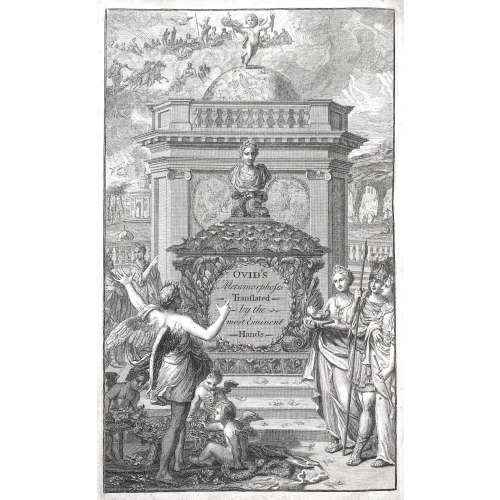 Title: OVID'S | METAMORPHOSES | IN | FIFTEEN BOOKS. | Translated by the most Eminent Hands. | Adorn’d with Sculptures | London: | Printed for Jacob Tonson at Shakespeare’s–Head | over-against Katharine-Street in the Strand. | M DCC XVII. || Physical description: Folio, laid paper, engraved title as frontispiece, letterpress title-page, portrait of the dedicatee, the Princess of Wales, engraved by George Vertue (British, 1684 – 1756) after Sir Godfrey Kneller (German, 1646 – 1723), [4] – dedication with headpiece vignette engraved by Elisha Kirkall (British, 1682 – 1742) after Peter Berchet (French, 1659 – 1720 London), [i]-xx – preface, [4] – contents, 1-548; collation: π3 a-f2, B-Zzzzzz2, +15 full-paged engravings, one heading each book; bound in full contemporary tan English calf blind-tooled with a darker panel, raised bands, crimson label with gilt lettering, sprinkled compartments with blind tooling, rebacked, later endpapers, 15 1/4 x 9 1/2 in (39.5 x 26 x 5 cm). Contributors: Author: Ovid (Roman, 43 B.C. – A.D. 17) Translator: Sir Samuel Garth (British, 1661 – 1719) Translator: John Dryden (British, 1631 – 1700) Translator: Joseph Addison (British, 1672 – 1719) Translator: John Gay (British, 1685 – 1732) Dedicatee / Sitter: Caroline Wilhelmina of Brandenburg-Ansbach, Princess of Wales, Queen of England (German-British, 1683 – 1737) Engraver: Elisha Kirkall (British, 1682 – 1742) Artist: Peter Berchet (French-British, 1659 – 1720) Artist: Sir Godfrey Kneller (German, 1646 – 1723) Engraver: George Vertue (British, 1684 – 1756) Engraver: Louis Du Guernier, the younger (French, 1677 – 1716) Engraver: Michael Vandergucht (Flemish, 1660 – 1725) Engraver: Elisha Kirkall (British, 1682 – 1742) Engraver: R. Smith (British, fl. early 18th century) Engraver: Matthys Pool (Dutch, 1670 – c. 1732) Publisher: Jacob Tonson, the Elder (British, 1655 – 1736)
Title: OVID'S | METAMORPHOSES | IN | FIFTEEN BOOKS. | Translated by the most Eminent Hands. | Adorn’d with Sculptures | London: | Printed for Jacob Tonson at Shakespeare’s–Head | over-against Katharine-Street in the Strand. | M DCC XVII. || Physical description: Folio, laid paper, engraved title as frontispiece, letterpress title-page, portrait of the dedicatee, the Princess of Wales, engraved by George Vertue (British, 1684 – 1756) after Sir Godfrey Kneller (German, 1646 – 1723), [4] – dedication with headpiece vignette engraved by Elisha Kirkall (British, 1682 – 1742) after Peter Berchet (French, 1659 – 1720 London), [i]-xx – preface, [4] – contents, 1-548; collation: π3 a-f2, B-Zzzzzz2, +15 full-paged engravings, one heading each book; bound in full contemporary tan English calf blind-tooled with a darker panel, raised bands, crimson label with gilt lettering, sprinkled compartments with blind tooling, rebacked, later endpapers, 15 1/4 x 9 1/2 in (39.5 x 26 x 5 cm). Contributors: Author: Ovid (Roman, 43 B.C. – A.D. 17) Translator: Sir Samuel Garth (British, 1661 – 1719) Translator: John Dryden (British, 1631 – 1700) Translator: Joseph Addison (British, 1672 – 1719) Translator: John Gay (British, 1685 – 1732) Dedicatee / Sitter: Caroline Wilhelmina of Brandenburg-Ansbach, Princess of Wales, Queen of England (German-British, 1683 – 1737) Engraver: Elisha Kirkall (British, 1682 – 1742) Artist: Peter Berchet (French-British, 1659 – 1720) Artist: Sir Godfrey Kneller (German, 1646 – 1723) Engraver: George Vertue (British, 1684 – 1756) Engraver: Louis Du Guernier, the younger (French, 1677 – 1716) Engraver: Michael Vandergucht (Flemish, 1660 – 1725) Engraver: Elisha Kirkall (British, 1682 – 1742) Engraver: R. Smith (British, fl. early 18th century) Engraver: Matthys Pool (Dutch, 1670 – c. 1732) Publisher: Jacob Tonson, the Elder (British, 1655 – 1736) -
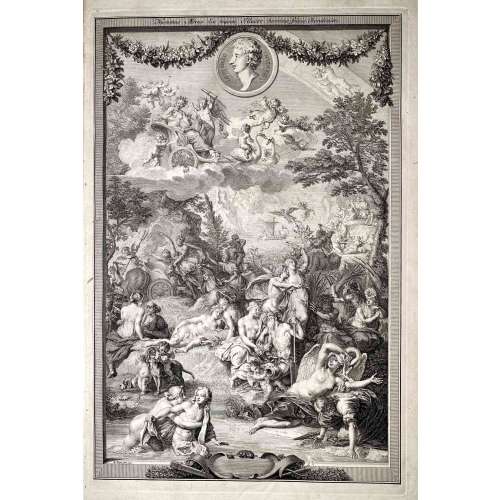 Vol. 1 title: OVID'S | METAMORPHOSES | IN LATIN AND ENGLISH, | TRANSLATED BY | THE MOST EMINENT HANDS. | With HISTORICAL EXPLICATIONS | Of the FABLES, | WRITTEN IN FRENCH BY | The ABBOT BANIER, | MEMBER OF THE ACADEMY OF INSCRIPTIONS | AND BELLES LETTRES. | TRANSLATED INTO ENGLISH. | Adorned with Sculptures, by B. Picart, and other able Masters. | VOLUME THE FIRST. | [Device] | AMSTERDAM, | Printed for the WETSTEINS and SMITH. | MD CC XXII || — Pagination: [26 – Half-title, frontis., t.p., dedic., The Bookseller's Preface To This Edition, Mr. Banier's Preface To The French Translation, Contents], [1] 2-247 – Text of books 1-7, with illus., [1 blank]. Vol. 2 half-title: OVID'S | METAMORPHOSES | IN LATIN AND ENGLISH | TWO VOLUMES || — Pagination: [2 – half-title / blank], 249-524 – Text of books 8-15, with illus., incl. 3 leaves of pl., [4 – Index]. Three leaves between pages 264 and 271 are included in the pagination as pp. [265-70] but do not carry page-numbers or letterpress text. They each carry two prints on their rectos and are blank on the verso. Vol. II without the engraved title page. The names of the translators are given in the list of Contents as Dryden, Addison, Eusden, Arthur Mainwaring, Croxall, Tate, Stonestreet, Vernon, Gay, Pope, Stephen Harvey, Congreve, Ozel, Temple Stanyan, , Catcot, Rowe, Samuel Garth, Welsted. The frontispiece is signed as made by B. Picart. The six plates on pages [265, 267, 269] are all signed as painted by C. Le Brun and engraved by Iakob Folkema. Of the 124 illustrations, most are unsigned by a draughtsman, but some are signed as designed by G. Maas, one as designed by Jul. Romain, two as designed by G. Maas and drawn by J. de Wit, one as drawn by 'HA', one as painted by C. le Brun, one as made by B. Picart, one as designed by P. Testa and drawn by B. Picart, one as designed by S. Le Clerc, one as designed by B. Picart. Many are signed by their engravers - Philip à Gunst (one as directed by B. Picart and engraved by Phil. à Gunst), J. Vandelaar (or I. Wandelaar), Martin Bouche, Jan Schenck, 'MB', Petr. Paul. Bouche, Iakob Folkema, W. Jongman, Fred. Bouttats. The title-page vignette of Volume I is signed as drawn by B. v. Overbeke and engraved by F. Mulder. Many tailpieces are signed 'VLS'. The book is dedicated by the publishers, R. and J. Wetstein and W. Smith, to the Countess of Pembroke. [Description is cited from the Royal Academy of Arts] Physical description: Two large 4to volumes, first title page printed in red and black, added engraved title in the first volume; half-title in the second volume; illustrated throughout with copperplate engravings in text; text printed in parallel columns in Latin and English; three leaves extraneous to collation each with two engravings in the second volume; bookplate pasted to the front endpaper in each volume: Ex Libris Theodore C. Tebbetts (Theodore Charles Tebbetts, American, 1871 – 1920) designed after Francis Carruthers Gould (British, 1844 – 1925); pages 517-520 of the second volume torn with loss of bottom blank corners and a word or two; original full leather, spines tooled elaborately in gilt; some boards detached, endcaps and corners rather worn, contents bright and fresh. Size: Large 4to; 47.5 x 31 cm.
Vol. 1 title: OVID'S | METAMORPHOSES | IN LATIN AND ENGLISH, | TRANSLATED BY | THE MOST EMINENT HANDS. | With HISTORICAL EXPLICATIONS | Of the FABLES, | WRITTEN IN FRENCH BY | The ABBOT BANIER, | MEMBER OF THE ACADEMY OF INSCRIPTIONS | AND BELLES LETTRES. | TRANSLATED INTO ENGLISH. | Adorned with Sculptures, by B. Picart, and other able Masters. | VOLUME THE FIRST. | [Device] | AMSTERDAM, | Printed for the WETSTEINS and SMITH. | MD CC XXII || — Pagination: [26 – Half-title, frontis., t.p., dedic., The Bookseller's Preface To This Edition, Mr. Banier's Preface To The French Translation, Contents], [1] 2-247 – Text of books 1-7, with illus., [1 blank]. Vol. 2 half-title: OVID'S | METAMORPHOSES | IN LATIN AND ENGLISH | TWO VOLUMES || — Pagination: [2 – half-title / blank], 249-524 – Text of books 8-15, with illus., incl. 3 leaves of pl., [4 – Index]. Three leaves between pages 264 and 271 are included in the pagination as pp. [265-70] but do not carry page-numbers or letterpress text. They each carry two prints on their rectos and are blank on the verso. Vol. II without the engraved title page. The names of the translators are given in the list of Contents as Dryden, Addison, Eusden, Arthur Mainwaring, Croxall, Tate, Stonestreet, Vernon, Gay, Pope, Stephen Harvey, Congreve, Ozel, Temple Stanyan, , Catcot, Rowe, Samuel Garth, Welsted. The frontispiece is signed as made by B. Picart. The six plates on pages [265, 267, 269] are all signed as painted by C. Le Brun and engraved by Iakob Folkema. Of the 124 illustrations, most are unsigned by a draughtsman, but some are signed as designed by G. Maas, one as designed by Jul. Romain, two as designed by G. Maas and drawn by J. de Wit, one as drawn by 'HA', one as painted by C. le Brun, one as made by B. Picart, one as designed by P. Testa and drawn by B. Picart, one as designed by S. Le Clerc, one as designed by B. Picart. Many are signed by their engravers - Philip à Gunst (one as directed by B. Picart and engraved by Phil. à Gunst), J. Vandelaar (or I. Wandelaar), Martin Bouche, Jan Schenck, 'MB', Petr. Paul. Bouche, Iakob Folkema, W. Jongman, Fred. Bouttats. The title-page vignette of Volume I is signed as drawn by B. v. Overbeke and engraved by F. Mulder. Many tailpieces are signed 'VLS'. The book is dedicated by the publishers, R. and J. Wetstein and W. Smith, to the Countess of Pembroke. [Description is cited from the Royal Academy of Arts] Physical description: Two large 4to volumes, first title page printed in red and black, added engraved title in the first volume; half-title in the second volume; illustrated throughout with copperplate engravings in text; text printed in parallel columns in Latin and English; three leaves extraneous to collation each with two engravings in the second volume; bookplate pasted to the front endpaper in each volume: Ex Libris Theodore C. Tebbetts (Theodore Charles Tebbetts, American, 1871 – 1920) designed after Francis Carruthers Gould (British, 1844 – 1925); pages 517-520 of the second volume torn with loss of bottom blank corners and a word or two; original full leather, spines tooled elaborately in gilt; some boards detached, endcaps and corners rather worn, contents bright and fresh. Size: Large 4to; 47.5 x 31 cm. -
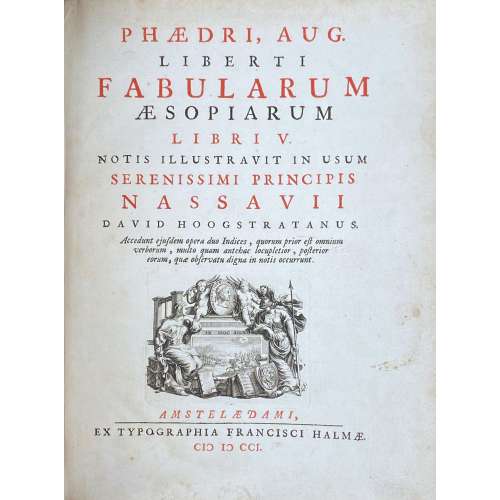 Phaedri, Aug. Liberti Fabularum Aesopiarum libri V / notis illustravit in usum serenissimi principis Nassavii David Hoogstratanus. Accedunt ejusdem opera duo indices, quorum prior est omnium verborum, multo quam antehac locupletior, posterior eorum, quae observatu digna in notis occurunt. — Amstelaedami : Ex Typographia Francisci Halmae, MDCCI [1701]. — pp.: [1] title, [1] (portr.), [32] 160, [84], 18 leaves of plates. Vita Phaedri is written by Johannes Schefferus (February 2, 1621 – March 26, 1679). Appendix fabularum is written by Marquard Gude (Gudius) (1 February 1635 – 26 November 1689). Gaius Julius Phaedrus was a 1st-century CE Roman fabulist and the first versifier of a collection of Aesop's fables into Latin. David van Hoogstraten (Rotterdam, March 14, 1658 - Amsterdam, November 21, 1724), a physician, poet and linguist, annotated the fables and dedicated them to Johan Willem Friso van Oranje-Nassau (14 August 1687 – 14 July 1711). The book was published in Amsterdam by François Halma (Langerak, January 3, 1653 - Leeuwarden, January 13, 1722), a Dutch printer, publisher and bookseller, with a portrait of Prince of Orange-Nassau, engraved by Pieter van Gunst (Dutch, Amsterdam 1659–1724) after Bernard Vaillant (Dutch, Lille 1632–1698 Leyden). The title page was engraved by P. Boutats after Jan Goeree (Dutch, Middelburg 1670–1731 Amsterdam). The edition is adorned throughout with 18 plates, each with 8 médaillons, designed and engraved by Jan van Vianen (Dutch, 1660–1726), and with vignettes, head- and tailpieces, inhabited initials, etc. Contemporary vellum over boards, title in red and back, red edges, 4to, 26 x 20 cm. Seller's description:4to, engraved general title, letterpress red & black title page with allegorical engraved vignette. 18 full-page copper-engraved plates by Jan van Vianen, each featuring six circular images, and 38 in-text reproductions, engraved decorative initials, and head- and tailpieces. Phaedrus (15 BC - 50 AD, Italy), was a "Roman fabulist, the first writer to Latinize whole books of fables, producing free versions in the iambic metre of Greek prose fables then circulating under the name of Aesop." (Ency. Brit.). This deluxe edition was specially created for the Prince of Nassau, profusely illustrated with fine engravings. Dibdin spoke highly of it in his Greek and Latin Classics (4th edition): "I have always considered this as a correct and very sumptuous edition. It is ornamented with a great number of small plates, or medallions, in which the subject of the fable is very ably and spiritedly executed.Ref.: Metropolitan Museum; Musée Médard
Phaedri, Aug. Liberti Fabularum Aesopiarum libri V / notis illustravit in usum serenissimi principis Nassavii David Hoogstratanus. Accedunt ejusdem opera duo indices, quorum prior est omnium verborum, multo quam antehac locupletior, posterior eorum, quae observatu digna in notis occurunt. — Amstelaedami : Ex Typographia Francisci Halmae, MDCCI [1701]. — pp.: [1] title, [1] (portr.), [32] 160, [84], 18 leaves of plates. Vita Phaedri is written by Johannes Schefferus (February 2, 1621 – March 26, 1679). Appendix fabularum is written by Marquard Gude (Gudius) (1 February 1635 – 26 November 1689). Gaius Julius Phaedrus was a 1st-century CE Roman fabulist and the first versifier of a collection of Aesop's fables into Latin. David van Hoogstraten (Rotterdam, March 14, 1658 - Amsterdam, November 21, 1724), a physician, poet and linguist, annotated the fables and dedicated them to Johan Willem Friso van Oranje-Nassau (14 August 1687 – 14 July 1711). The book was published in Amsterdam by François Halma (Langerak, January 3, 1653 - Leeuwarden, January 13, 1722), a Dutch printer, publisher and bookseller, with a portrait of Prince of Orange-Nassau, engraved by Pieter van Gunst (Dutch, Amsterdam 1659–1724) after Bernard Vaillant (Dutch, Lille 1632–1698 Leyden). The title page was engraved by P. Boutats after Jan Goeree (Dutch, Middelburg 1670–1731 Amsterdam). The edition is adorned throughout with 18 plates, each with 8 médaillons, designed and engraved by Jan van Vianen (Dutch, 1660–1726), and with vignettes, head- and tailpieces, inhabited initials, etc. Contemporary vellum over boards, title in red and back, red edges, 4to, 26 x 20 cm. Seller's description:4to, engraved general title, letterpress red & black title page with allegorical engraved vignette. 18 full-page copper-engraved plates by Jan van Vianen, each featuring six circular images, and 38 in-text reproductions, engraved decorative initials, and head- and tailpieces. Phaedrus (15 BC - 50 AD, Italy), was a "Roman fabulist, the first writer to Latinize whole books of fables, producing free versions in the iambic metre of Greek prose fables then circulating under the name of Aesop." (Ency. Brit.). This deluxe edition was specially created for the Prince of Nassau, profusely illustrated with fine engravings. Dibdin spoke highly of it in his Greek and Latin Classics (4th edition): "I have always considered this as a correct and very sumptuous edition. It is ornamented with a great number of small plates, or medallions, in which the subject of the fable is very ably and spiritedly executed.Ref.: Metropolitan Museum; Musée Médard -
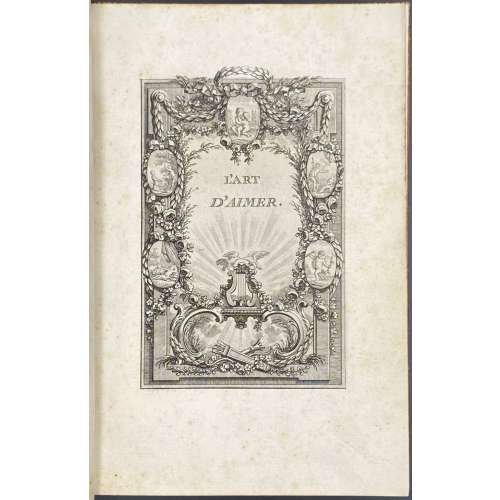 Title: L'ART | D'AIMER, | ET | POÉSIES DIVERSES | DE M. BERNARD. Pagination: [2] – t.p. / stanza by Voltaire; engraved t. p., frontispiece, [1] 2-170; pp. 1-61 – L'art d'aimer; pp. 62-111 – Phrosine et Mélidore; pp. 112-170 – Poésies diverses; illustrations. Collation: 8vo; π1 (letterpress t.p.), A-K8 L5; + 8 plates: (1)* engraved title page facing the stanza by Ch. Baquoy; (2) plate as a frontispiece by Ponce after Ch. Eisen, inscribed Chant I above the image, dated 1772, facing p. [1], chant 1er of l’art; (3)* Ch. Baquoy after P. Martini, inscribed Chant II below the image, facing p. 22, chant 2nd of l’art; (4) Ch. Baquoy after Eisen, inscribed Chant III above the image, facing p. 44, chant 3rd of l’art; (5)* Patas after P. Martini, inscribed Chant Ier below the image, dated 1775, facing p. 62, chant 1er of Phrosine; (6) Ch. Baquoy after Eisen, inscribed Chant II above the image, facing p. 74, chant 2nd of Phrosine; (7)* C. Gaucher after P. Martini, facing p. 84, chant 3rd of Phrosine; (8) Ch. Baquoy after Eisen, inscribed Chant IV above the image, facing p. 97, chant 4th of Phrosine; * – images additional to 1772 edition by Le Jay [LIB-2706.2021] (i.e. plates 1, 3, 5, and 7 are new). A counterfeit edition by an anonymous publisher. Binding: brown pebbled morocco, triple fillet gilt-ruled boards, raised bands, gilt in compartments, gilt label lettering to spine, marbled endpapers, AMG; printed on laid paper, with tall 's'. Catalogue raisonné: Cohen, De Richi (1912): p. 132: describes a counterfeit edition with 170 pages and 3 additional plates plus an engraved title. This seems to be a combination of Lejan [sic] Paris 1775 edition, which normally has 134 pages, 8vo, title engraved by Baquoy and three plates after Martini by Patas, Baquoy and Gaucher. Contributors: Nicolas Ponce (French, 1746 – 1831) – engraver. Jean Charles Baquoy (French, 1721 – 1777) – engraver. Jean-Baptiste Patas (French, 1748 – 1817) – engraver. Charles-Étienne Gaucher (French, 1740 – 1804) – engraver. Charles-Dominique-Joseph Eisen (French, 1720 – 1778) – artist. Pietro Antonio Martini (Italian, 1738 – 1797) – artist. Pierre-Joseph Bernard [Gentil-Bernard] (French, 1708 – 1775) – author of the text.
Title: L'ART | D'AIMER, | ET | POÉSIES DIVERSES | DE M. BERNARD. Pagination: [2] – t.p. / stanza by Voltaire; engraved t. p., frontispiece, [1] 2-170; pp. 1-61 – L'art d'aimer; pp. 62-111 – Phrosine et Mélidore; pp. 112-170 – Poésies diverses; illustrations. Collation: 8vo; π1 (letterpress t.p.), A-K8 L5; + 8 plates: (1)* engraved title page facing the stanza by Ch. Baquoy; (2) plate as a frontispiece by Ponce after Ch. Eisen, inscribed Chant I above the image, dated 1772, facing p. [1], chant 1er of l’art; (3)* Ch. Baquoy after P. Martini, inscribed Chant II below the image, facing p. 22, chant 2nd of l’art; (4) Ch. Baquoy after Eisen, inscribed Chant III above the image, facing p. 44, chant 3rd of l’art; (5)* Patas after P. Martini, inscribed Chant Ier below the image, dated 1775, facing p. 62, chant 1er of Phrosine; (6) Ch. Baquoy after Eisen, inscribed Chant II above the image, facing p. 74, chant 2nd of Phrosine; (7)* C. Gaucher after P. Martini, facing p. 84, chant 3rd of Phrosine; (8) Ch. Baquoy after Eisen, inscribed Chant IV above the image, facing p. 97, chant 4th of Phrosine; * – images additional to 1772 edition by Le Jay [LIB-2706.2021] (i.e. plates 1, 3, 5, and 7 are new). A counterfeit edition by an anonymous publisher. Binding: brown pebbled morocco, triple fillet gilt-ruled boards, raised bands, gilt in compartments, gilt label lettering to spine, marbled endpapers, AMG; printed on laid paper, with tall 's'. Catalogue raisonné: Cohen, De Richi (1912): p. 132: describes a counterfeit edition with 170 pages and 3 additional plates plus an engraved title. This seems to be a combination of Lejan [sic] Paris 1775 edition, which normally has 134 pages, 8vo, title engraved by Baquoy and three plates after Martini by Patas, Baquoy and Gaucher. Contributors: Nicolas Ponce (French, 1746 – 1831) – engraver. Jean Charles Baquoy (French, 1721 – 1777) – engraver. Jean-Baptiste Patas (French, 1748 – 1817) – engraver. Charles-Étienne Gaucher (French, 1740 – 1804) – engraver. Charles-Dominique-Joseph Eisen (French, 1720 – 1778) – artist. Pietro Antonio Martini (Italian, 1738 – 1797) – artist. Pierre-Joseph Bernard [Gentil-Bernard] (French, 1708 – 1775) – author of the text. -
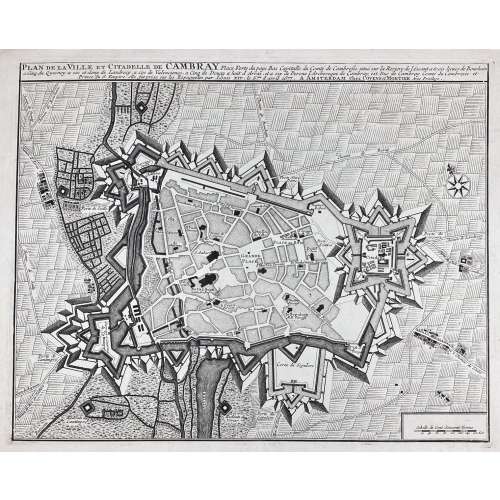
Plan de la ville et citadelle de Cambray : place forte du pays bas capitalle du Comté Cambresis situé sur la riviere de l'Escaut a trois lieues de Bouchain, a cinq du Quesnoy, a six et demy de Landrecy, a six de Valenciene, a cinq de Douay, a huit d'Arras, et a six de Perone, l'Archeveque de Cambray est Duc de Cambray, Comté du Cambresis et Prince du S. Empire, elle fut prix sur les espagnoles par Louis XIV, le 5.me d'April 1677; A AMSTERDAM Chez Covens & Mortier, Avec Privilege.
Date of publication: [between 1721 and 1778].
Dimensions: Sheet: 48 x 58.3 cm; Image: 38.2 x 47.7 cm. Earlier editions of the same were by Pierre Husson in the Hague (ca. 1715) and by Eugene Henry Fricx in Brussels (1710). -
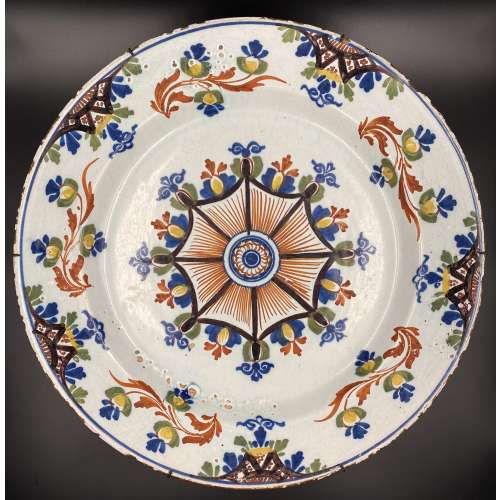 Round plate with an underglaze polychrome design of a blue border and stylized flowers on the rim and octagonal ornament at the centre. Diameter: 34 cm, Haight: 4 cm.
Round plate with an underglaze polychrome design of a blue border and stylized flowers on the rim and octagonal ornament at the centre. Diameter: 34 cm, Haight: 4 cm. -
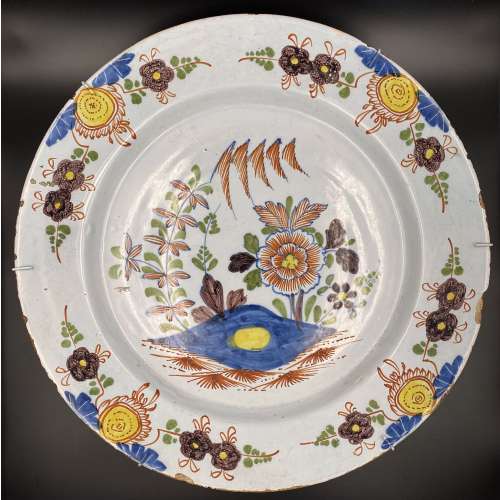 Round plate with a polichrome design of repeating stylized flowers on the rim and a pond reflecting the sun surounded by flowers at the centre. Diameter: 34 cm, Haight: 4 cm.
Round plate with a polichrome design of repeating stylized flowers on the rim and a pond reflecting the sun surounded by flowers at the centre. Diameter: 34 cm, Haight: 4 cm.


